USS Hornet, CV-8, in 1/350 scale, Merit International kit# 81009 OOB Review and Build
My Review and Build of Merit International Kit #89001, World war II Aircraft carrier, USS Hornet, CV-8, Doolitlle Raid
Note: You can also see all of the pcitures from this page in full resolution on the Flickr Album Here on Flickr. Otherwise, click on the picture here and you will get a higher resolution version here.
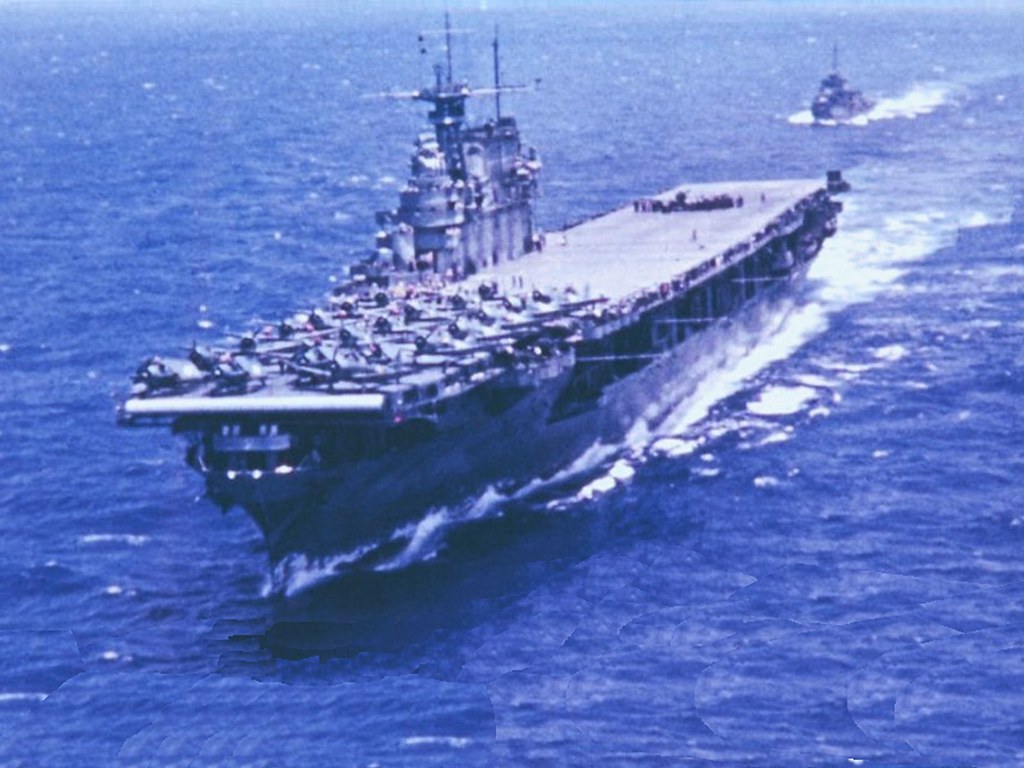
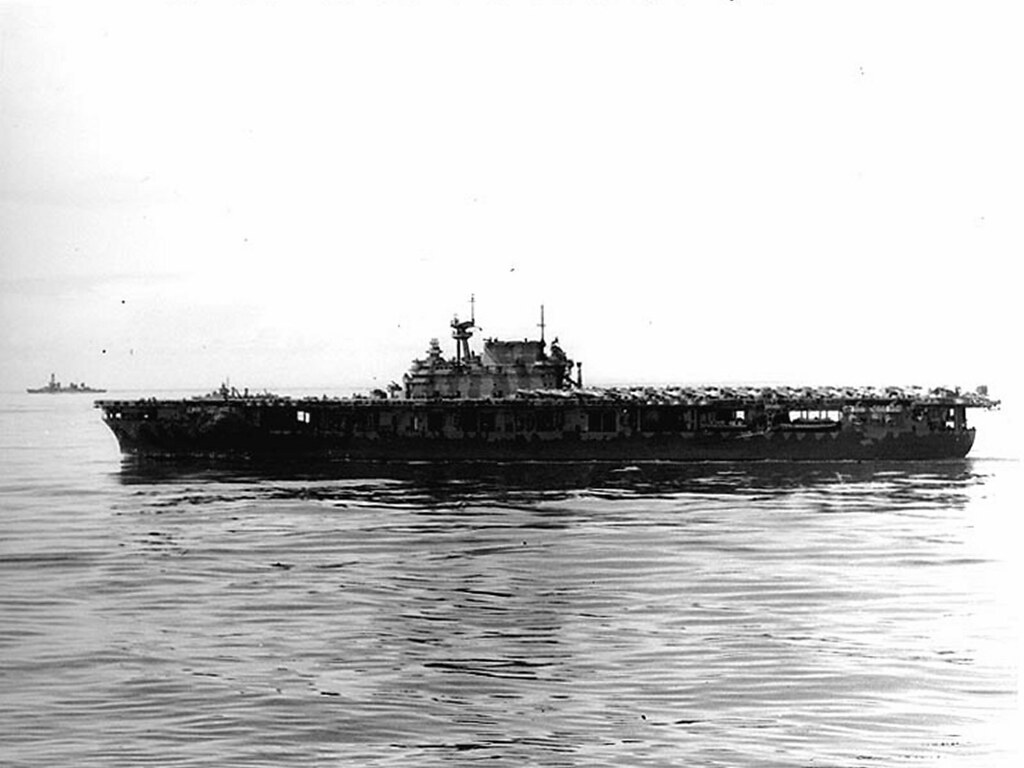
This build is of an already built model. it comes painted and with 12 B-25 Bombers. However, I addded the Tom's Model and GOld Medal Model Photo Etch Kits, as well as building four more B-25s to get the depiction up to the 16 aircraft that took off of the carrier to raid Tokyo in April of 1942, just four months after the Japanese attacked Pearl Harbor in December 1941, and at a time when the Japanese were winning every battle and engageent in the PAcific, and taking all of the islands and territories they attacked.
It was at a time when the outcome of the war was in doubt, when US moral was low, and when nothing seemed to be able to top or inflict serious damage on the Japnese after their suprise attack.
In April of this year, it will be the 75th anniversary of the Doolittle Raid on Tokyo. The men who took part in that raid were among the most universally admired and revered men in the United States. They still are, though only two or the of them are left alinve now.
The Doolittle Raid on Japan in April 1942
There were eighty men who took to the air as Jimmy Doolittle's Raiders in April 1942, when they carried out one of the most courageous and heart-stirring military operations in this nation’s history. The mere mention of their unit’s name back in the 1940s after the event was likely to bring tears to the eyes of grateful Americans.
After Japan’s surprise attack on Pearl Harbor, with the United States reeling and wounded, something dramatic was needed to help turn the war effort around, and encourage Americans. It was only four months since the surprise attack...and to that point, as already stated, all of the news had been bad.
Even though there were no friendly airfields close enough to Japan for the United States to launch a retaliation strike with its bombers, a daring plan was devised to retaliate just the same.
The raid got started when President Franklin D. Roosevelt, expressed to the Joint Chiefs of Staff in a meeting at the White House on 21 December 1941, two wweeks after Pearl Harbor, that Japan be bombed as soon as possible to boost public morale after the disaster at Pearl Harbor.
The concept for the actual attack had its genesis with then Navy Captain Francis Low, Assistant Chief of Staff for anti-submarine warfare, who reported to Admiral Ernest J. King. On January 10, 1942 he told his superiors that he thought twin-engine Army bombers could be launched from an aircraft carrier. He mentioned that after observing several B-25s at a naval airfield in Norfolk, Virginia, where the runway was painted with the outline of a carrier deck for landing practice. When he saw how close some of them came to taking off in the distance shown, he had the idea that maybe, just maybe something could be done.
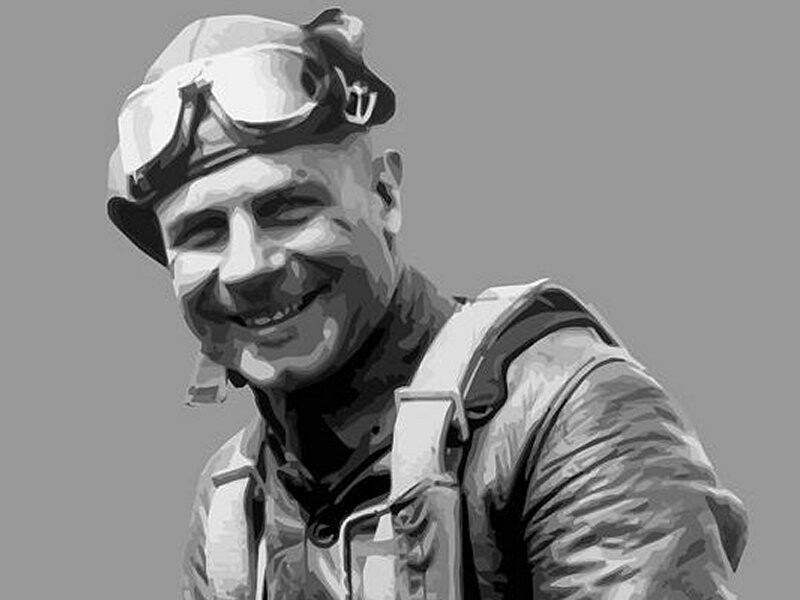
The idea ultimately found its way to Lt. Colonel Jimmy Doolittle, who already a famous military test pilot, civilian aviator and aeronautical engineer before the war.
What if the US could use B-25 Mitchell bombers? What if the bombers could be taken aboard an aircraft carrier and launched? The thought seemed impossible.
Even though by all rights those bombers were too heavy and normally took far too long to take-off and get into the air, Lt. Colonel Jimmy Doolittle.
He believed it could be done and he set about preparing to do devise a plan to make it happen.
The nation's Commander in Chief, President Roosevelt, and its military leadership believed him. They knew that the United states had to make a statement. They new they needed a victory, and they were willing to take an audacious risk to make it happen. And they chose Colonel Doolittle to lead the force.
Lt. Dolonel Jimmy Doolittle's History:
After World War I, when he was a flight instructor in the United States, Doolittle became famous as a pilot and aeronautical engineer with an MS from MIT. He developed a reputation showing that he believed in things that others felt could not be done, or were not ready to be done.
In May 1921, as an engineering officer and pilot, when a US aircraft crash landed in a Mexican canyon on a tans-continental flight attempt, Doolittle was sent to retrieve it. His team reached the plane on May 3rd and found it serviceable. They returned on May 8th with a replacement motor and four mechanics.
After installing, they found that the oil pressure of the new motor was inadequate, Using carrier pigeons, Doolittle requested two pressure gauges. The additional parts were dropped by air and installed, and Doolittle himself then flew the plane to Del Rio, Texas himself, taking off from a 400-yard airstrip hacked out of the canyon floor.
Here are some of the firsts he had accomplished:
- 1st cross-country flight, in September 1922, from Pablo Beach (later renamed Jacksonville Beach), FL, to Rockwell Field, San Diego, CA.
- 1st to perform an outside loop, which was thought to be a universally fatal maneuver, with a Curtiss fighter at Wright Field in 1927.
- 1st pilot, in 1929, to take off, fly and land an airplane using instruments alone, without a view of the outside of the aircraft.
- 1st pilot to use artificial horizon and directional gyroscope, equipment.
- 1st quantities of 100 octane aviation gasoline produced with Doolittle's help for high performance aircraft.
- Set the world high speed record for land planes in 1932 at 296 miles per hour.
This is the man the President of the United states and the military leaders called on to devise and then lead the force in the audacious attempt to retaliate against Japan.
The Plan to use B-25s off of a US Navy aircraft carrier"
After Captian Lwws initial thoughts, and Jimmy Doolittle's thinking, the country chose the B-25 Mitchell medium bomber. Although at that point it was untested in combat, Doolittle believed it could be modified to make the mission. A big part of that modification was to reduce their weight and so anything unnecessary to the bombing mission and flight was removed...including many of the aircraft's self defense guns.
The 17th Bomb Group in the 8th Air Force was chosen to provide the pool of crews from which volunteers would be recruited. The 17th BG had been the first group to receive B-25s, with all of its squadrons equipped by September 1941. The 17th was the first medium bomb group of the U.S. Army Air Corps. In early 1942, it also had the most experienced B-25 crews flying antisubmarine patrols from Pendleton, Oregon.
As a result of the decision to use the B-25, and to use this group, the 17th BG was immediately moved cross-country to Lexington County Army Air Base at Columbia, South Carolina to prepare for the mission against Japan. On February 9th, only two months after Pearl Harbor, ts combat crews were offered the opportunity to volunteer for an "extremely hazardous" but unspecified mission. By February 17th, they had their men and this group was detached from the Eighth Air Force.
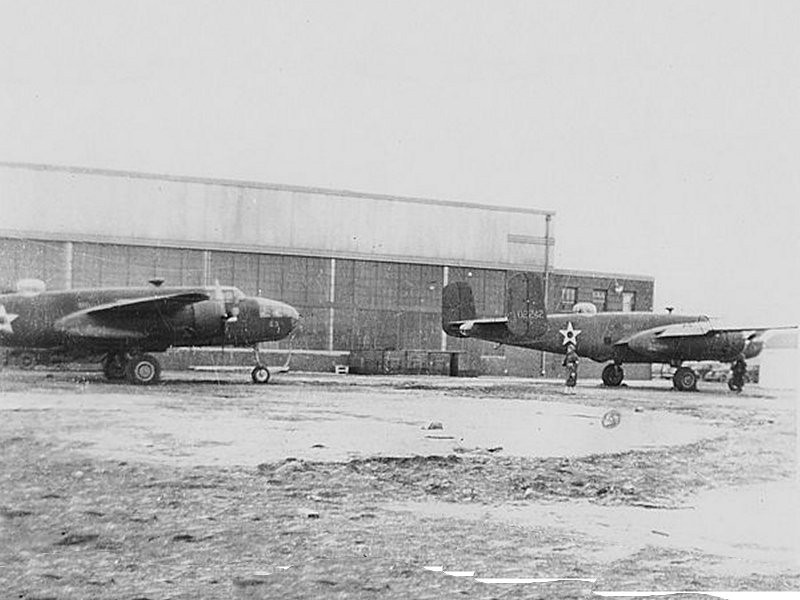
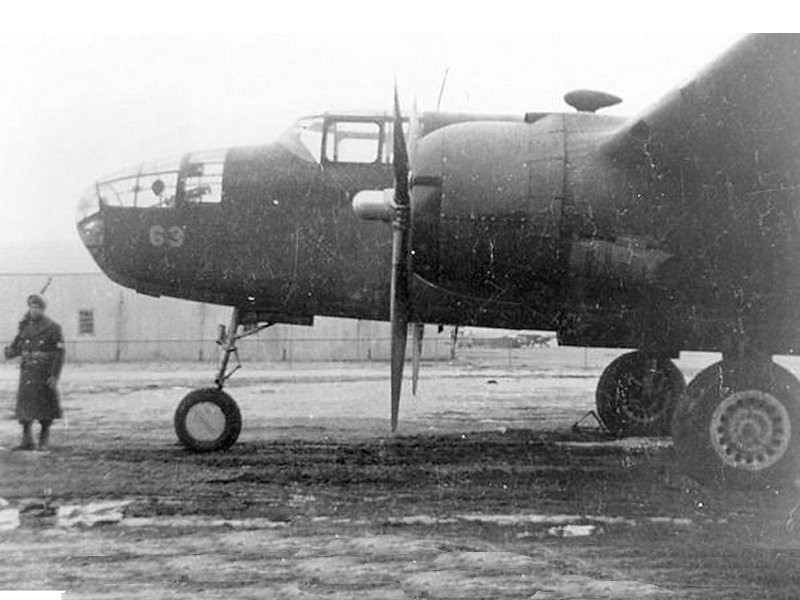
Twenty bombers were diverted to the Mid-Continent Airlines modification center in Minneapolis, Minnesota. The 710th Military Police Battalion from Fort Snelling, provided tight security around the modification process. Modifications to the aircraft included:
- Removal of the lower gun turret
- Remove tail guns.
- Installation of de-icers and anti-icers.
- New Steel blast plates mounted on the fuselage around the upper turret
- Removal of the liaison radio set.
- Install additional 160-gallon auxiliary fuel tank & support mounts for additional tanks to increase capacity to 1,141 gallons
- Install Mock gun barrels in the tail cone, and
- Replace Norden bombsight with a makeshift aiming sight so the top secret Norton bombsight would not fall into enemy hands
The B-25s were modified. This resulted in their being able to reliably take take off from the deck of an aircraft carrier and perform their long range mission...which was a one way mission...to bomb Tokyo.
The selected crews retrieved the modified aircraft in Minneapolis and then flew them to Eglin Field, Florida. There, beginning March 1st, 1942, these crews received intensive training in simulated carrier deck takeoffs, low-level and night flying, low-altitude bombing and over-water navigation. For three weeks they operated out of Wagner Field, Auxiliary Field 1.
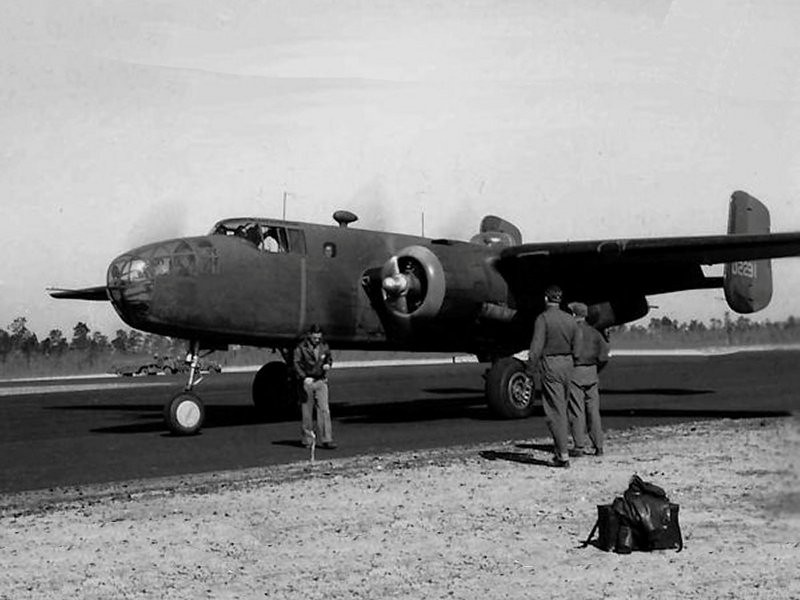
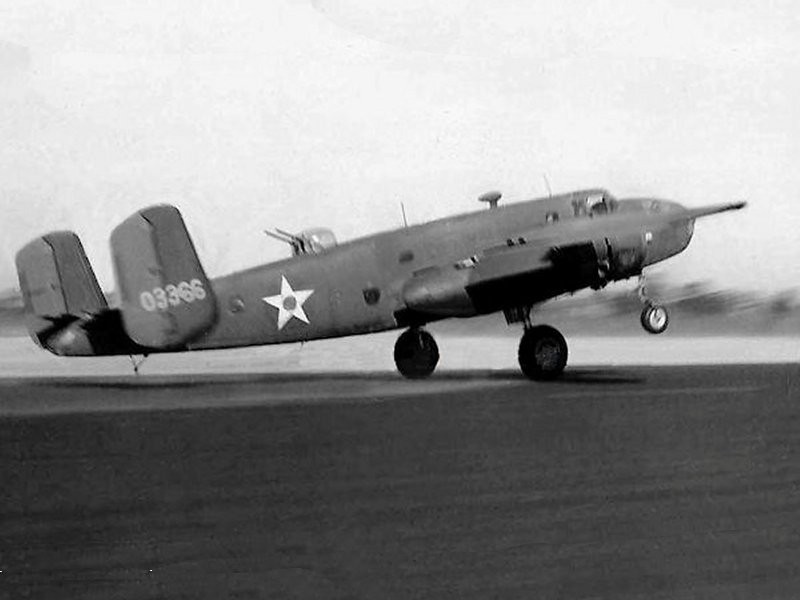
These crews had to practice...and practice...and practice again, until in the right wind conditions, they could lift off from their practice airfields before the markers that indicated the end of the carrier deck.
On March 25, 1942, the B-25s flew to the Sacramento Air Depot for final modifications. They were then flown to Alameda Naval Air Station, on the 31st of March. Fifteen aircraft were actually to be the attack force at first, with the 16th to be flown off shortly after departure from San Francisco to provide feedback to Army pilots. But, the 16th bomber was made part of the attack force after departure instead.
Loading the aircraft on the USS Hornet and gathering the entire Task Force to attack Japan:
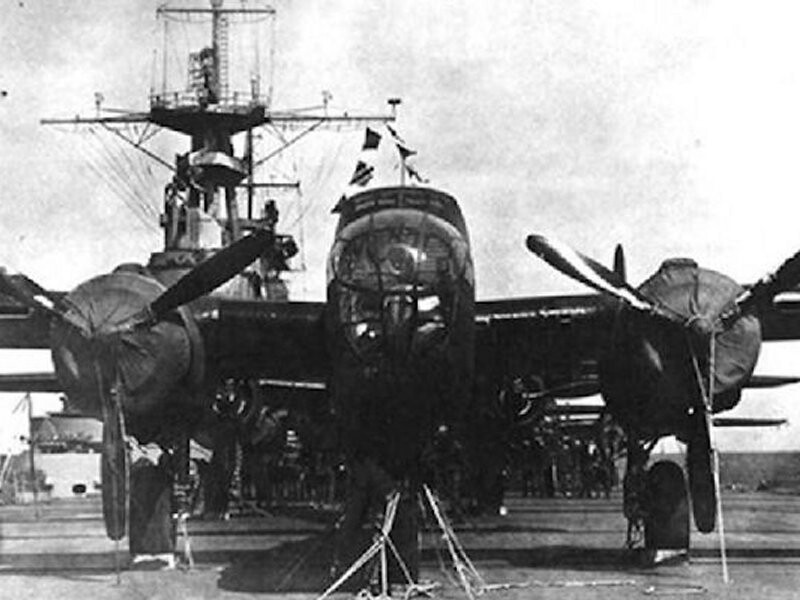
On April 1st, 1942, the 16 bombers, their five-man crews and Army maintenance personnel, totaling 71 officers and 130 enlisted men, were loaded onto the USS Hornet at Naval Air Station Alameda. Each aircraft carried four specially constructed 500-pound (225 kg) bombs.
Three of these were high-explosive munitions and the fourth was incendiaries.
All of the Army Air Corps personnel were under the command of Colonel Doolittle himself, who would fly the lead plane. They would take off from the Hornet. The Hornet would be accompanied by the US Navy aircraft carrier, USS Enterprise, which would provide the fighter aircraft carrier coverage for the task force as they sailed towards Japan. The two carriers would be escorted by four cruisers and eight destroyers.
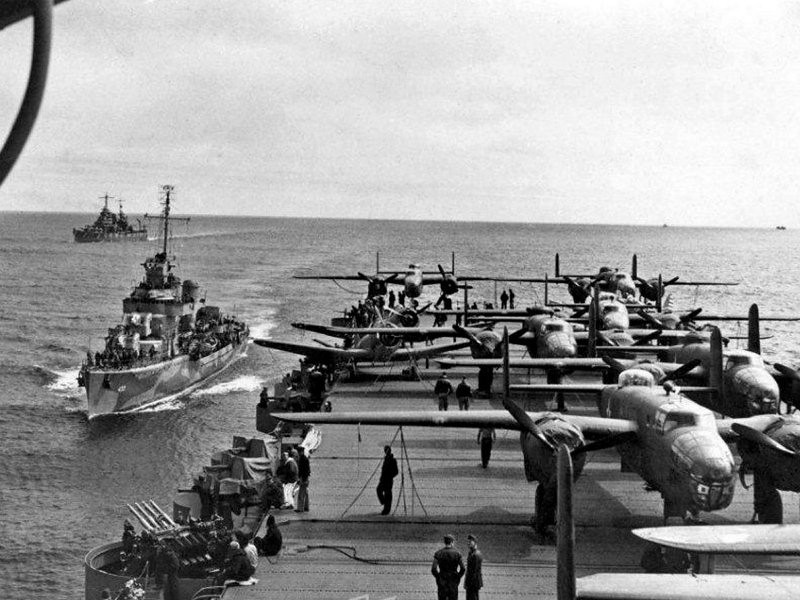
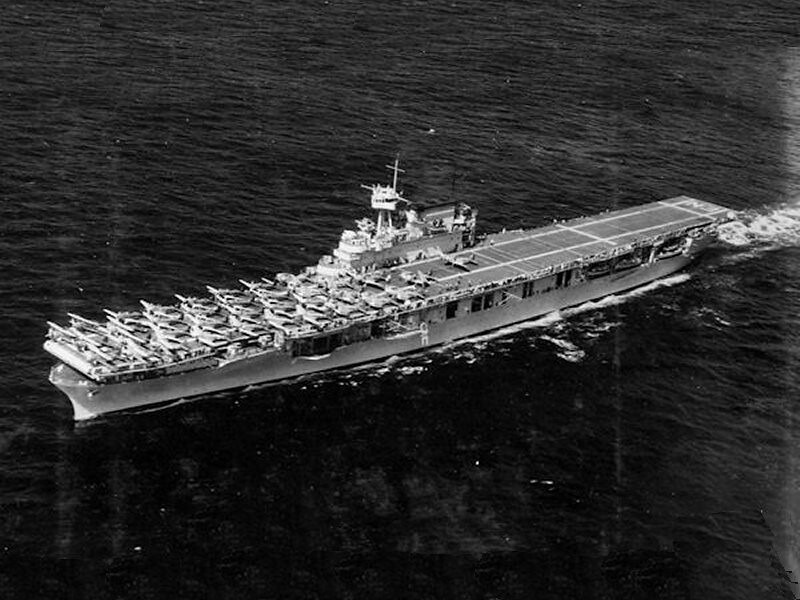
The Hornet and her escorts made up Task Force 18, and they departed Alameda at 10:00 on April 2, 1942. A few days later they rendezvoused with Task Force 16, commanded by Vice Admiral William F. Halsey, Jr. and the Enterprise and her escorts in the mid-Pacific Ocean north of Hawaii, and proceeded towards Japan in high secrecy and conducting radio silence.
The resulting taks force was TF 16, and was made up of:
2 x Carriers
3 x Heavy Cruisers
1 x Light Cruiser
8 x Destroyers
2 x Replensihment ships
Fourteen combatants. As note as to the severity of the overall war effort, half of the surface force did not survive the war. Ultimately (as shall be seen) the Hornet was sunk, two of the cruisers and four of the destroyers were all sunk due to enemy action during the course of the war at places like off Guadalcanal and the Santa cruz islands.
Nonetheless, this was a mammoth undertaking for the US Navy Pacific fleet at the time, which had been baldy damaged at Honolulu...there were no battleships available to the Pacific fleet because they had all been either sunk or damaged on December 7, 1941. This was half of the aircraft carriers available at the time. Losing these vessels could have spelled a near fatal blow to the US Navy...which was already reeling from the Pearl Harbor attack and other defeats.
Yet the US leadership took the risk and made the bold step of committing this mich of their remaining fire power to thi effort.
En route the personnel maintained their aircraft, and also marked up the ordinance for deliver to Tojo in Japan. They met often to discuss the mission.
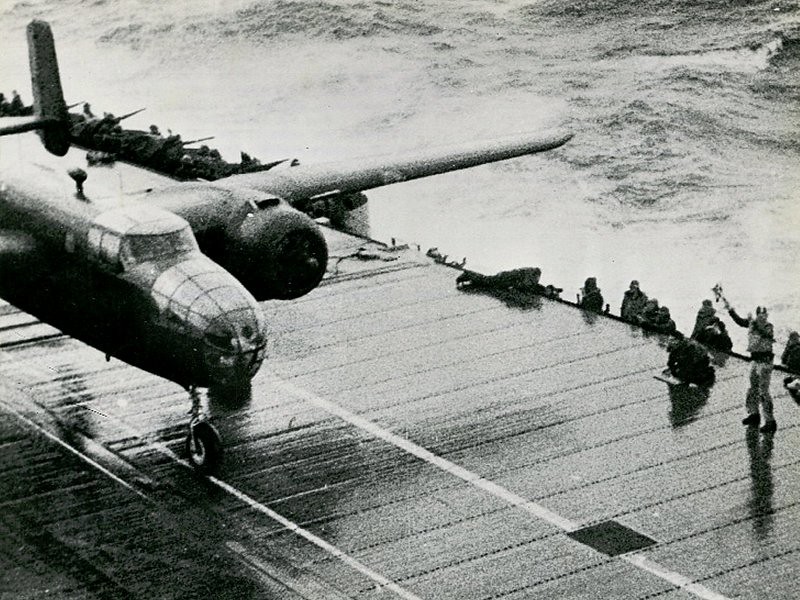
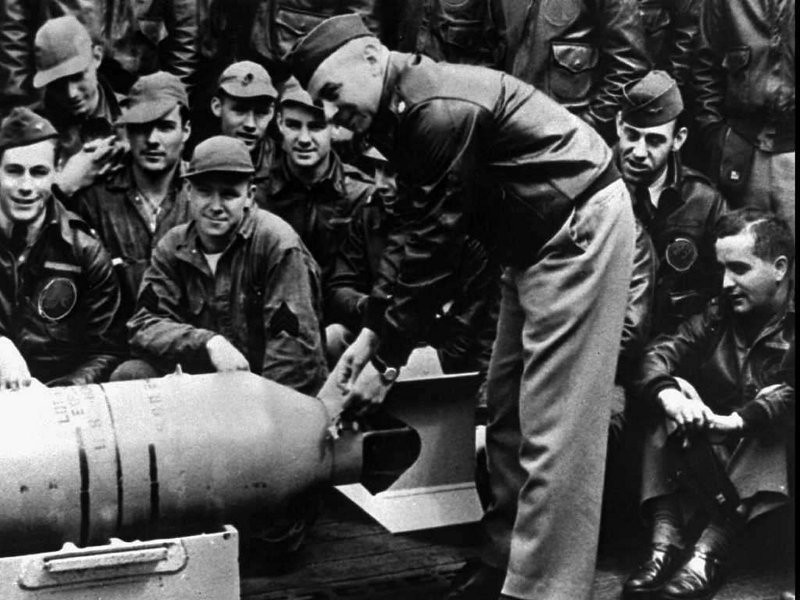
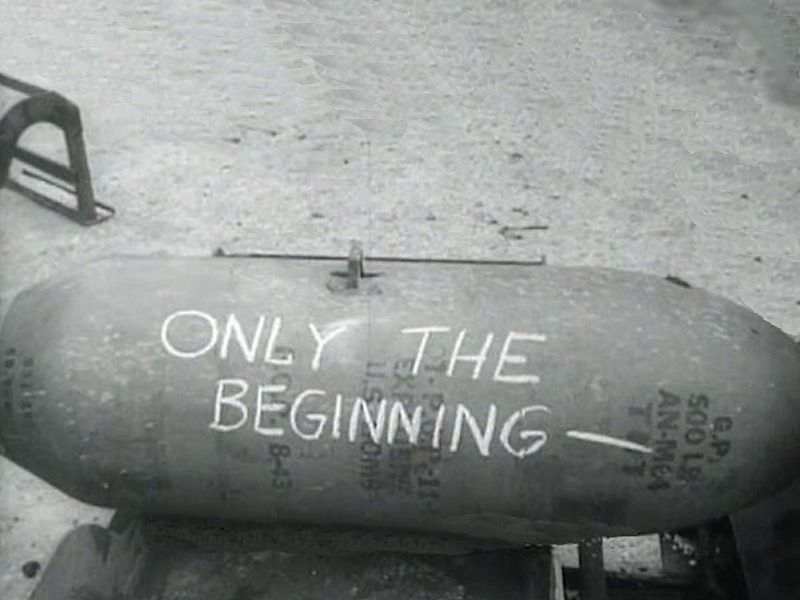
Early launch of the aircraft and the attack on Japan:
At 07:38 on the morning of April 18th, over two weeks after leaving California, and while still 650 nautical miles from Japan, the Task force was sighted by a Japanese picket boat. It was the Nitto Maru, a 70-ton patrol craft. The Nitto Maru radioed a warning to Japan.
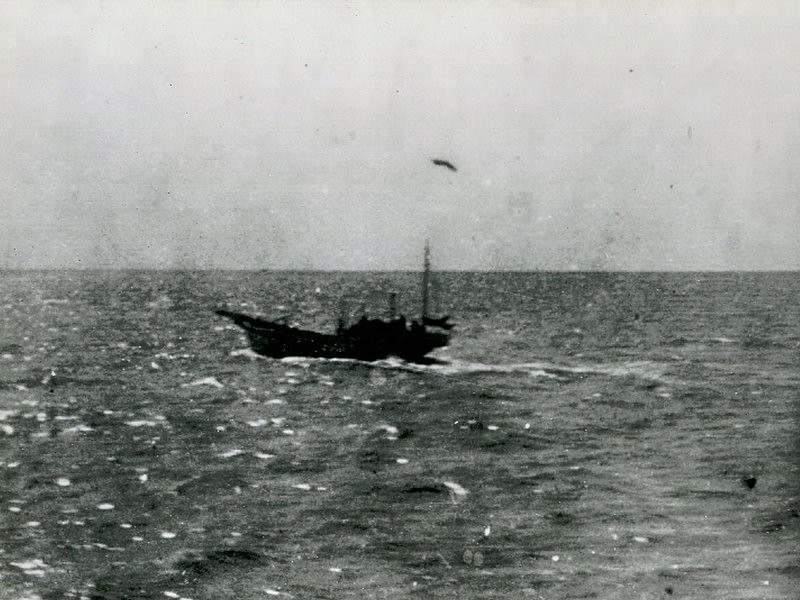
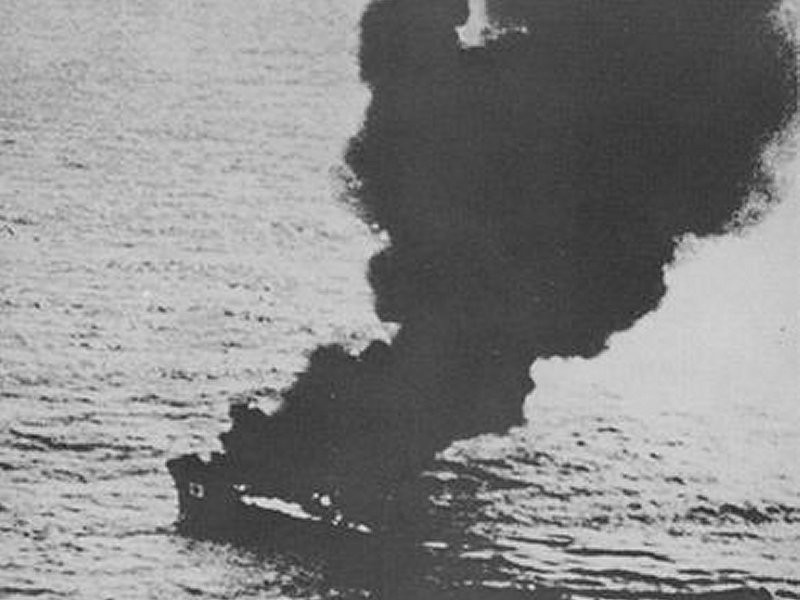
This boat was sunk by gunfire from one of the Hornet's escorts, the USS Nashville. The chief petty officer commanding the Japanese boat committed suicide but five of the crew survived and were picked up by Nashville.
Doolittle and the Hornet skipper, Captain Marc Mitscher, decided to launch the B-25s immediately...10 hours early and 170 nautical miles farther from Japan than planned. They knew that they would now not have enough fuel to make it to safety in China as they had planned.
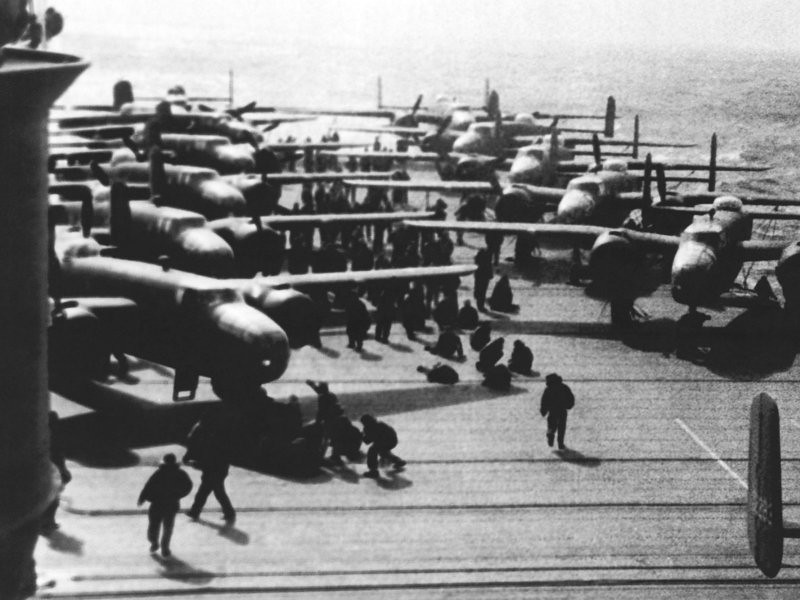
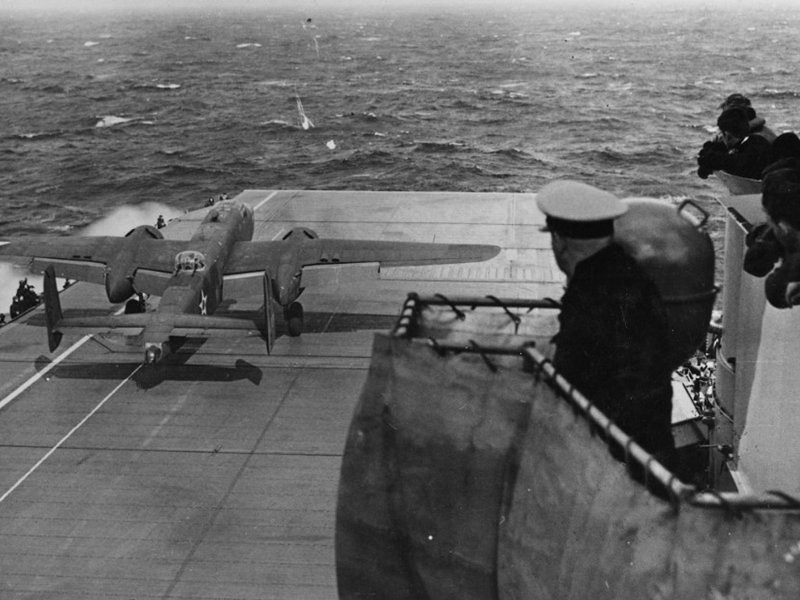
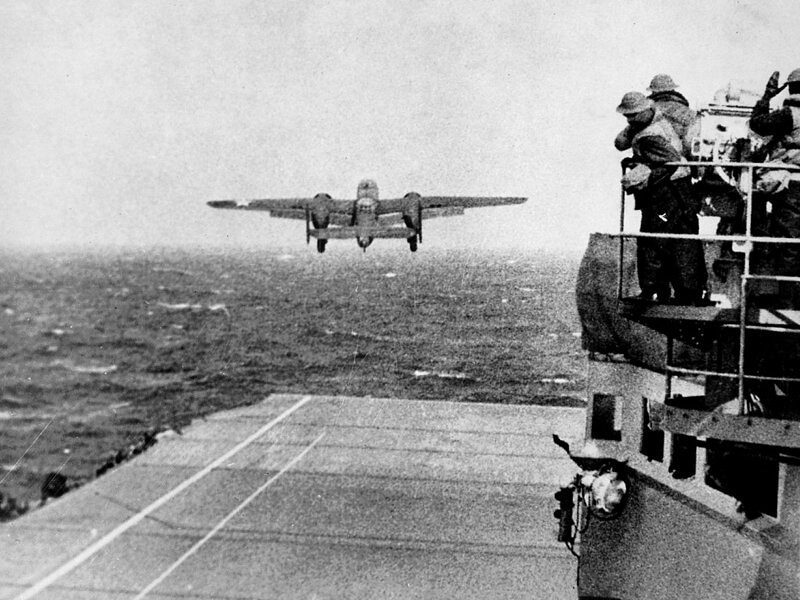
...but they went anyway.
The bombers flew to Japan in groups of two to four aircraft. As they approached the coast, they dropped to wave top level and flew in single file. They crossed the coast and then gained altitude and began arriving over Tokyo about noon Tokyo time, six hours after launch.
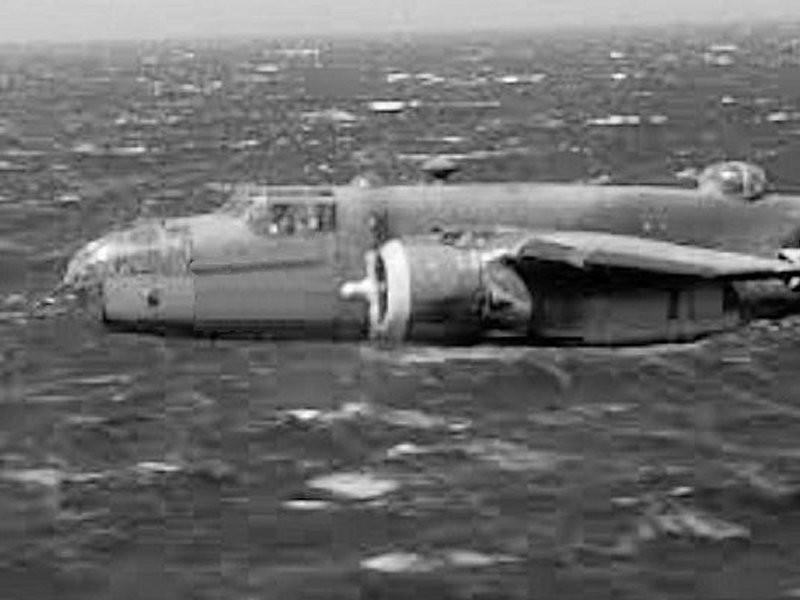
They caught the Japanese by complete surprise and bombed 10 military and industrial targets in Tokyo, two in Yokohama and one each in Yokosuka, Nagoya, Kobe and Osaka. As they flew on, a few encountered light antiaircraft fire, but no aircraft were shot down. Several military factories were hit, and a Japanese aircraft carrier, the Ryhuo, which was in dry dock, was also hit by bombs from one of the aircraft, tearing a large hole/rip in her side and causeing her to remain in dock much longer to repair this damge.
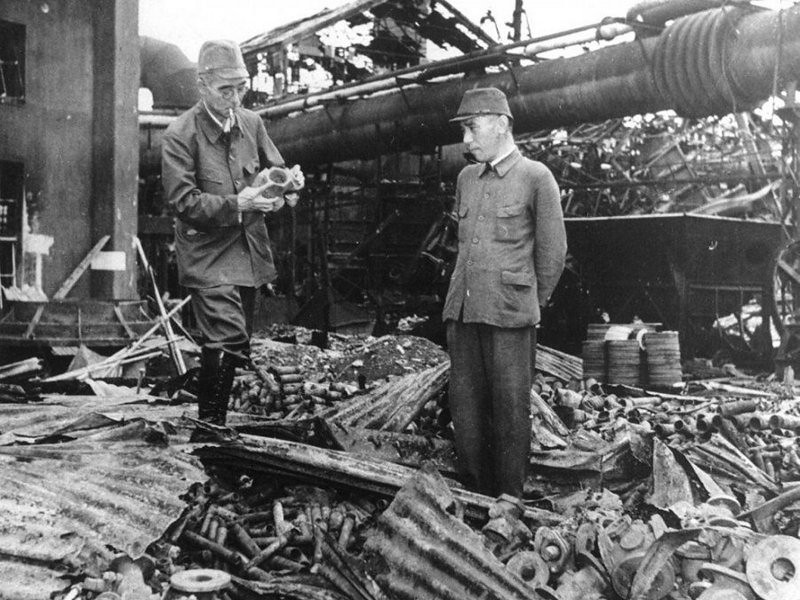
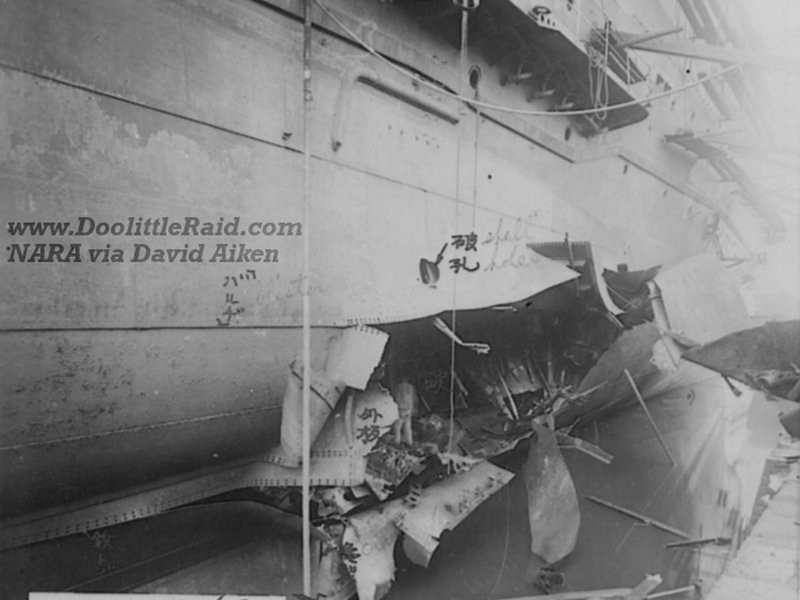
Only one aircraft, that of Lt. Richard O. Joyce received any battle damage, and these were minor hits from antiaircraft fire.
One aircraft, piloted by Lt. Everett W. Holstrom, had to jettison its bombs early when it came under attack by a fighter. Other fighters ultimately took off to try and catch the bombers and at least one was shot down by the gunners of the Whirling Dervish, piloted by Lieutenant Harold Watson. Two other fighters were shot down by the gunners of the Hari Kari-er, piloted by Ross Greening.
Many military targets were strafed by the bombers' nose gunners.
Fifteen of the aircraft flew southwest along the southern coast of Japan and across the East China Sea to eastern China. There were several air fileds in Zhejiang province which were supposedly ready and would be using using homing beacons. The plan was for the aircraft to recover and refuel at those fields and then continue on to Chongqing, the wartime capital.
Because of the early sighting buy the Japanese, Halsey was unable to send the arranged for singal to alert the Chinese fields, due to the threat to the entire task force. In addition, becauxe of the early take-off...the aircraft began running out of fuel.
Crash Landings in China, one aircraft diverts to Russia:
One B-25, piloted by Capt. Edward J. York, was extremely low on fuel, and flew towards the Soviet Union because it was closer.
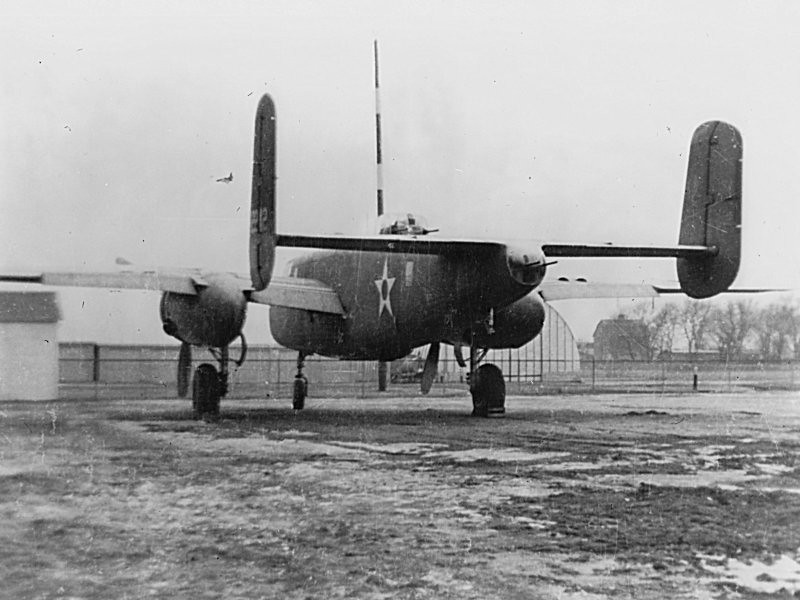
The United States had attempted to negotiate with the Soviet Unbion beofre the attack to allow all aircraft to land on its filed. They were closer and the idea was to then give the bombers to the Soviets as Land-lease material and have the crews recovered to the United States. ut Stalin and his negotiators, who wanted to maximize their ability to gain land from the Japanese, decided to remain neutral to Japan, and the deal was never made.
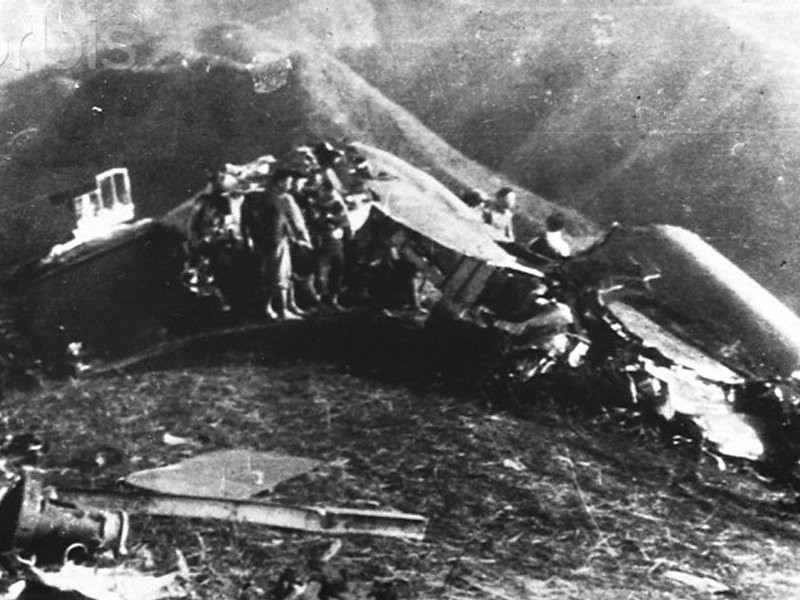
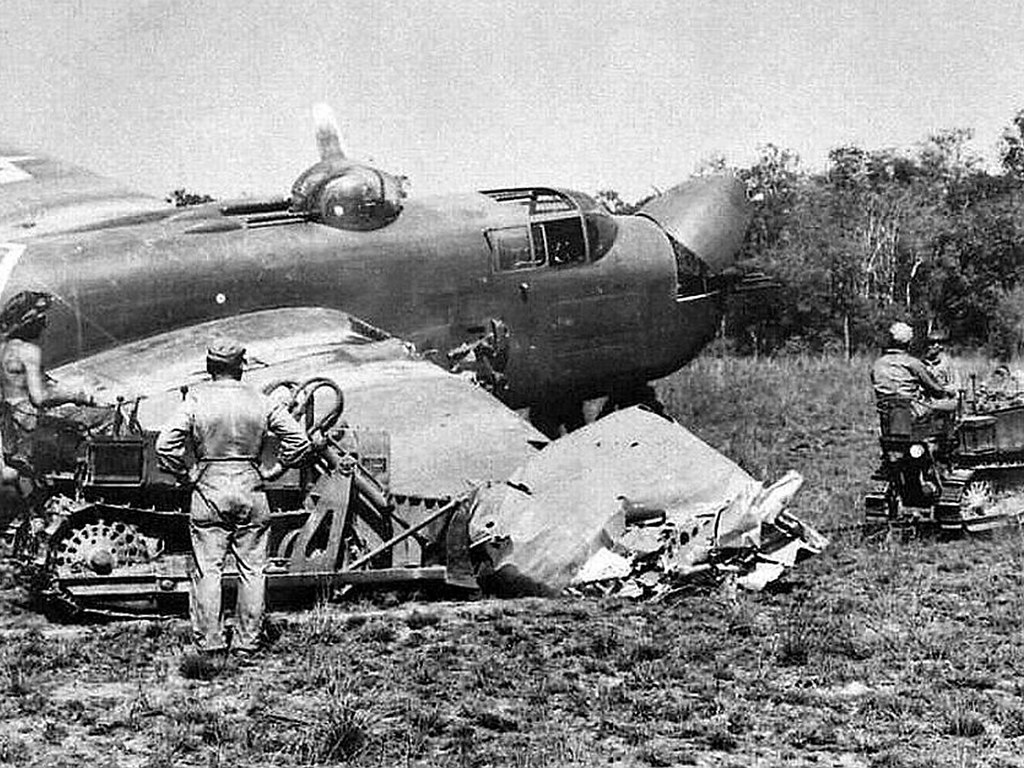
As a result of all of this, four aircraft had to crash land short of any airfield at all. Eleven more crews bailed out, short on fuel and parachuted to the gorund. The one aircraft did make it to the Soviet Union, where they were interred by the Soviets.
Three personnel died while landing or parachuting. Eight personnel were captured by the Japanese. Three of those captured were executed. Another one of those captured died of starvation in a Japanese prison camp.
The rest were helped by the Chinese people and Chinese soldiers and escaped the Japanese. The Japanese extracted a horrible retribution on the Chinese for helping the American crews to scape. it is estimated that thousands were rounded up and killed in the effort to find the Americans, or punish the Chinese for helping them.
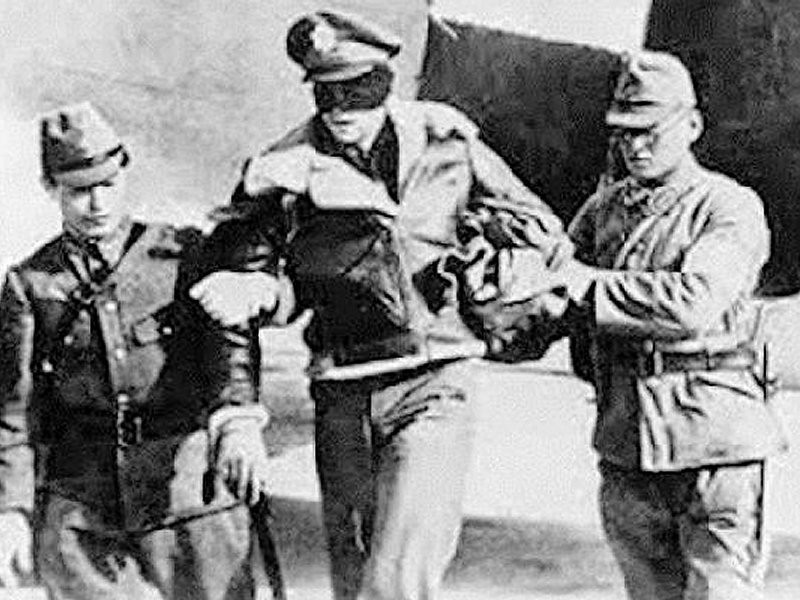
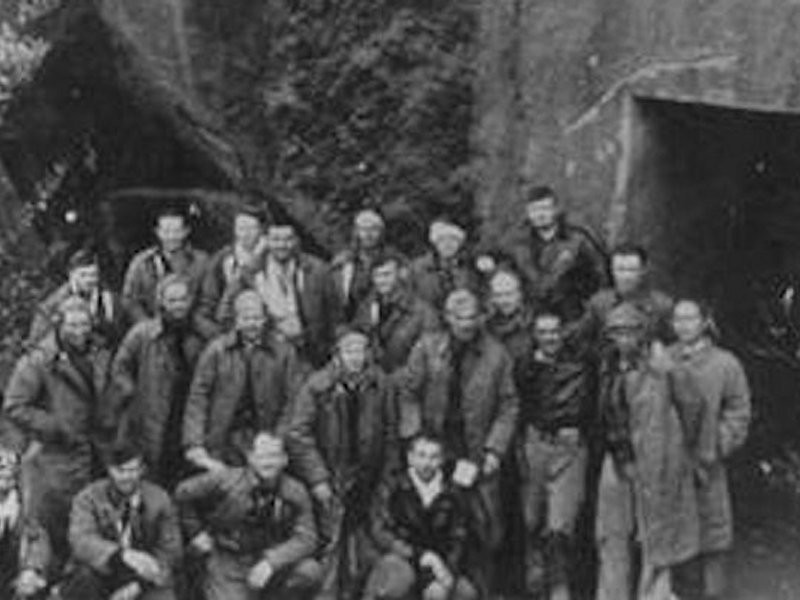
Twenty-eight of them stayed in China after the attack, flying missions for more than a year. Five of these were killed in action.
Nineteen crew members went on to flew combat missions from North Africa after returning to the United States, Four of these were killed in action and four more became prisoners of war after being shot down and captured.
Nine crew members served in Europe after returning to the United States. One of these was killed in action.
Altogether 12 of the survivors died in air crashes within 15 months of the raid.
Two survivors were separated from the Army Air Coprs in 1944 due to the severity of their injuries.
Colonel Dollittle promoted to General and received Medal of Honor:
Colonel Doolittle, because he lost all 16 aircraft, and because of not being able to get all of his personnel back, thought that the mission was a failure and expected to be court martialed when he returned home.
However, the mission was, in reality an unqualified success. The Japanese were taken completely by surprise and had to divert m many more squadrons of their aircraft to defend the home islands against potential future raids. in addition, when the news of the attack was published back in the United states and to US military personnel, the impact on moral and attitude were instantaneous.
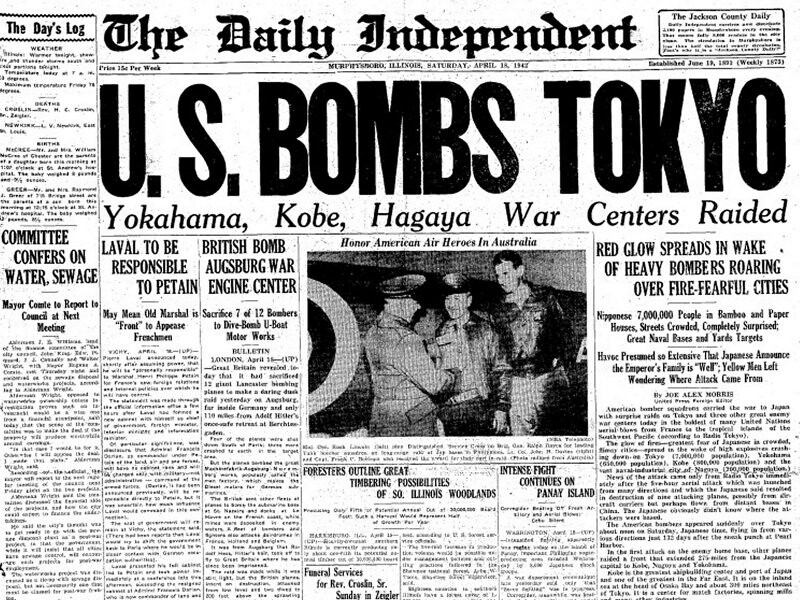
The United States sent an unqualified message to its enemies with the Doolittle Raid, one of commitment, one of audacity, one of doing whatever it took to strike back at the enemy and win the war. The Japanese received the message loud and clear.
Colonel Doolittle received the Medal of Honor for the mission, Several other received th3e Silver Sta. Doolittle was promoted two full levels to Brigadier General. He along with many of the others, as previously stated, went on to serve their nation in combat throughout the remainder of the war.
The following chart shows a good review of the overall effort and the vessels involved and their fates:
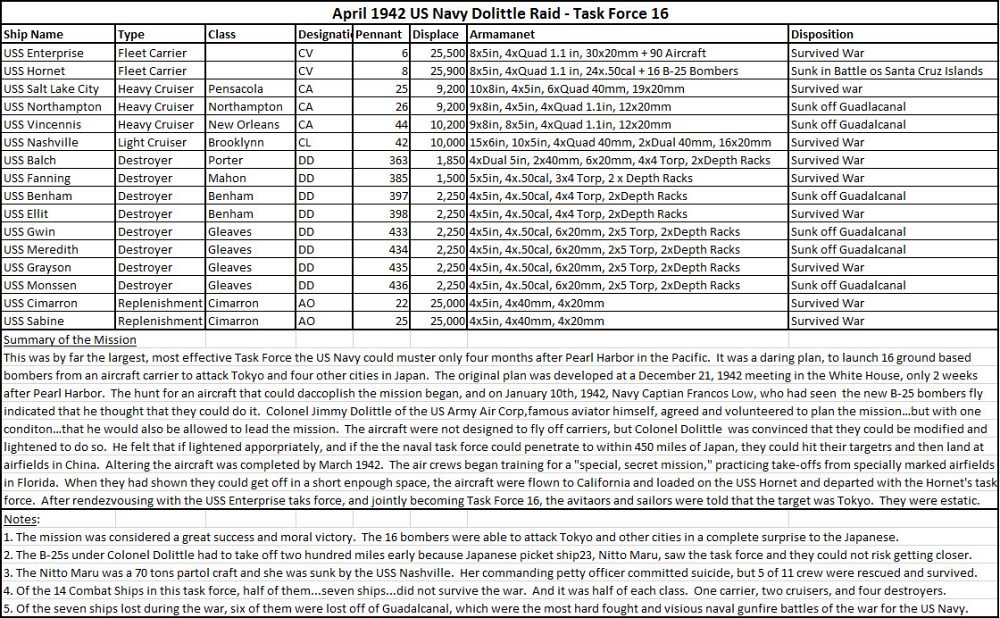
Specific Fate of the USS Hornet Tragically, the USS Hornet, did not survuve the war.
Though the mission to attack Japan was bold, there was still a long war to fight against a very capable foe.
In June 1942, at Midway, the United States, who had broken the Japanese codded message, achieved aa monumental victory over the Japanese at Midway Island. USS Hronet, USS Yorktown and USS Enterprise wre able to sink four Jaanese carriers there, at the loss of the USS Yorktwon. The Honet aircraft were involved in the attacks on the carriers and other shipping, sinking the heavy cruiser Mikuma, damaging a destroyer, and leaving the heavy cruiser Mogami, heavily damaged and on fire, to limp away from the battle zone.
The Hornet continued in the fighting whith a large portion then moved South around Gualdalcanal.
In October 1942, sixth months after the Tokyo raid, the USS Hornet was a part of the Battle of Santa Cruz Island.
On October 26, 1942, USS Enterprise's planes bombed the carrier Zuiho, while planes from Hornet severely damaged the carrier Shokaku and the heavy cruiser Chikuma. Two other cruisers were also attacked by Hornet's warplanes.
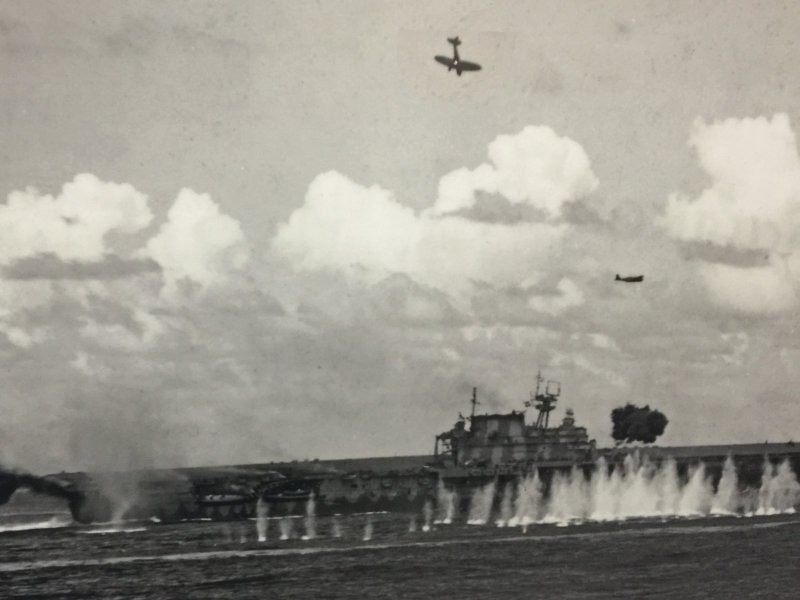
Meanwhile, Hornet was attacked by a coordinated dive bomber and torpedo plane attack. In a 15-minute period, Hornet was hit by three bombs from "Val" dive bombers. One "Val", after being heavily damaged by anti-aircraft fire while approaching Hornet, crashed into the carrier's island, killing seven men and spreading burning gas over the deck. Meanwhile, a flight of "Kate" torpedo planes attacked Hornet and scored two hits, which seriously damaged the electrical systems and engines. As the carrier came to a halt, another damaged "Val" deliberately crashed into Hornet's port side near the bow.
The Hornet was severly damaged. With power knocked out to her engines, Hornet was unable to launch or land aircraft, forcing its aviators to either land on Enterprise or ditch in the ocean. Rear Admiral George D. Murray ordered the heavy cruiser Northampton to tow Hornet clear of the action. Since the Japanese planes were attacking Enterprise at that time, this allowed Northampton to tow Hornet at a speed of about five knots (6 mph).
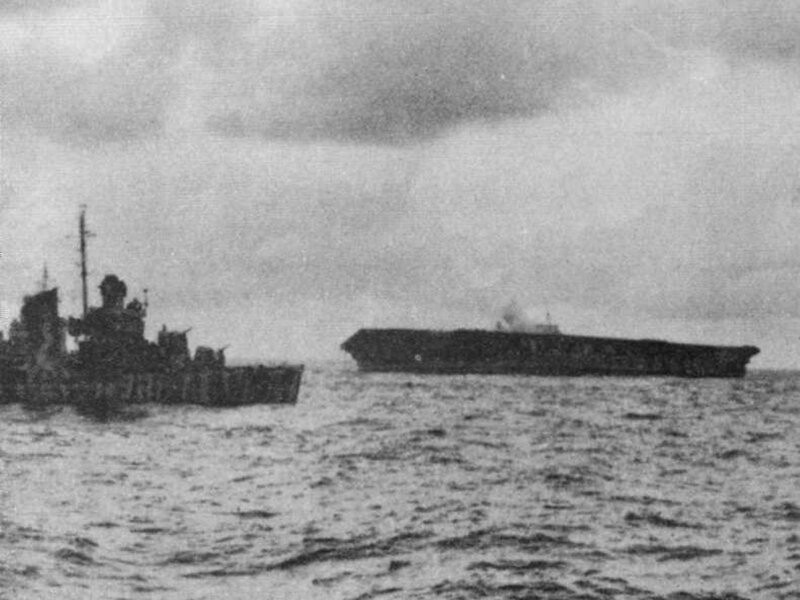
Repair crews were on the verge of restoring power when another flight of nine "Kate" torpedo planes attacked. Eight of these aircraft were either shot down or failed to score hits, but the ninth scored a hit on the starboard side. This hit destroyed the repairs to the electrical system and caused a 14-degree list. After being informed that Japanese surface forces were approaching and that further towing efforts were futile, Vice Admiral William Halsey ordered Hornet sunk, and an order of "abandon ship" was issued. Captain Charles P. Mason, the last man on board, climbed over the side, and the survivors were soon picked up by the escorting destroyers.
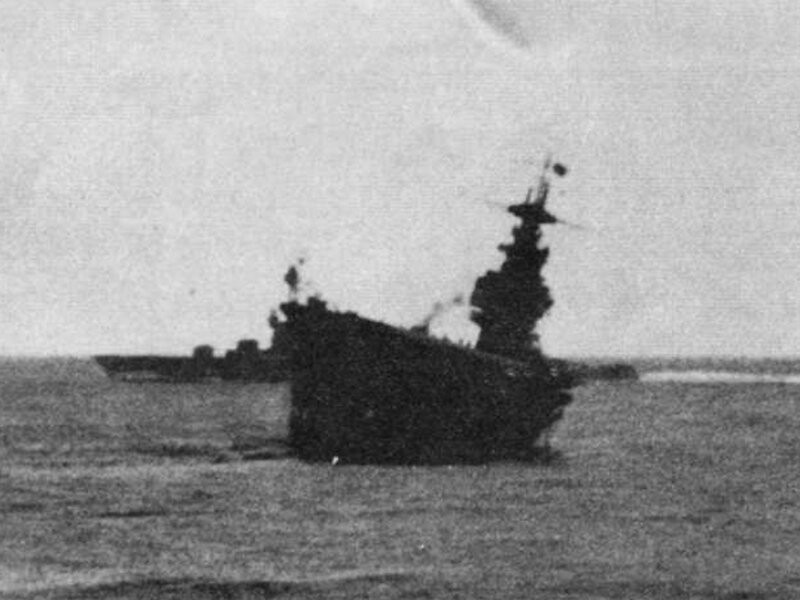
American warships next attempted to scuttle the stricken carrier, which absorbed nine torpedoes, many of which failed to explode, and more than 400 5-inch (130 mm) rounds from the destroyers Mustin and Anderson. The destroyers steamed away when a Japanese surface force entered the area.
The Japanese destroyers Makigumo and Akigumo finally finished off Hornet with four 24-inch (610 mm) Long Lance torpedoes. At 01:35 on 27 October, Hornet was finally sunk with the loss of 140 of her sailors
Such was the end of one of America's fleet carriers, which had inspired millions of Americans, but was sunk in as a part of the continuing war effort.
Her sister carrier, the USS Enterprise whnt on to survive the war and became the most decorated US Naval ship in history...that model will also be built as a part of this project and her stroy told at that time.
Afterwards: What happned during and after the war to the Surviving members of the Flight Crews:
Of the 80 Raiders, 62 survived the war. They were celebrated as national heroes, models of bravery. A motion picture based on the raid called, “Thirty Seconds Over Tokyo,” was produced starring Spencer Tracy and Van Johnson. That movie, released during the war in 1944, was a patriotic and emotional box-office hit.
Beginning in 1946, the surviving Raiders have held a reunion each April, to commemorate the mission. The reunion was in a different city each year. In 1959, the city of Tucson, Arizona, as a gesture of respect and gratitude, presented the Doolittle Raiders with a set of 80 silver goblets. Each goblet was engraved with the name of a Raider. In addition, within the wooden case a bottle of 1896 Hennessy cognac was included. From that year because 1896 was when Jimmy Doolittle was born.
As for Doolittle, his decorations ultimately included the Medal of Honor, Distinguished Flying Service Cross with one Oak leaf Cluster, Silver Star, Distinguished Flying Cross with two Oak Leaf Clusters, Bronze Star, Air Medal with three Oak Leaf Clusters, the Chinese Order of Yung ***, 3rd Class and eight other foreign decorations.
He retired from the U.S. Air Force Reserve as a Lieutenant General...the only Reserve officer to ever retire in that rank. He was promoted to Major General in 1985 by special act of Congress, and he died in 1993, just short of his 97th birthday.
After the 1959 Gobles and Cognac presentation to the group, the Raiders devised a plan for it. The plan was to toast their fallen comrades each year from the goblets, but as for the Cognac itself, they planned to wait until there are only two of them left...only then they would open the bottle of 1896 Hennessy Cognac and use it to toast their comrades who preceded them in death.
The 70th anniversary of the mission was in 2012.
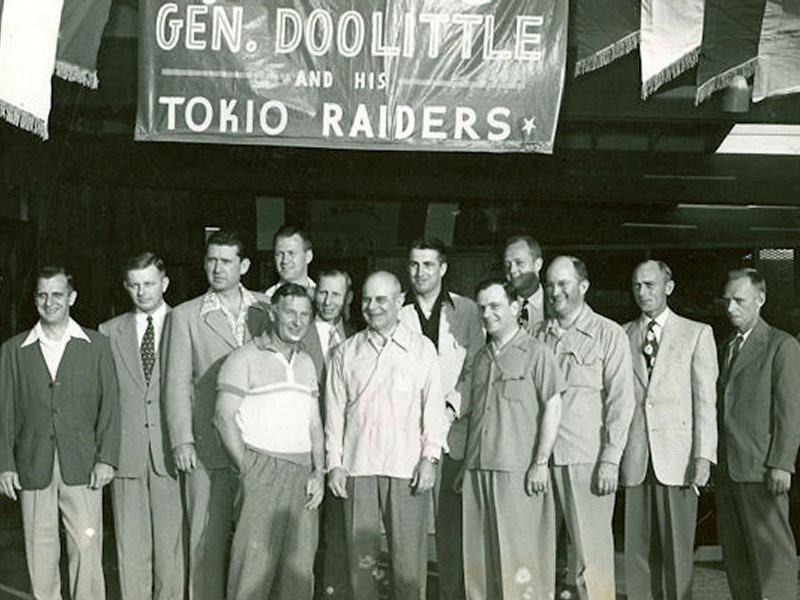
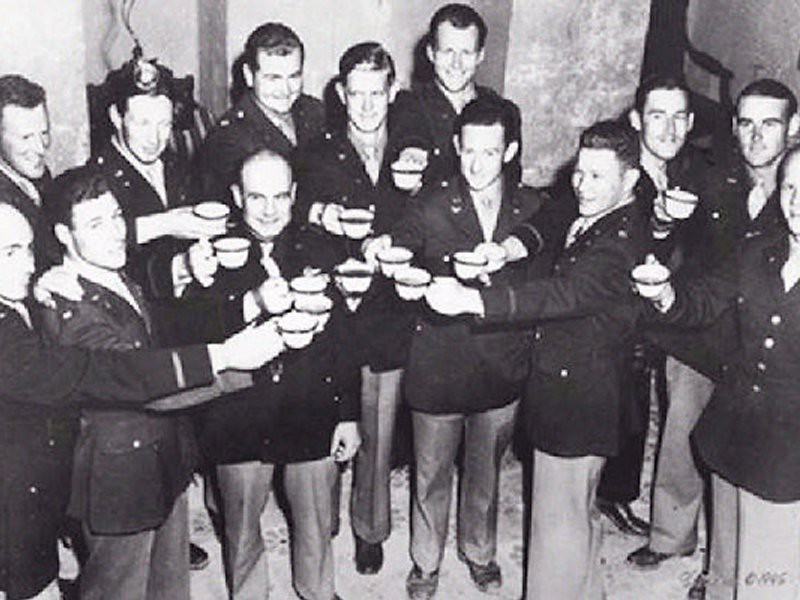
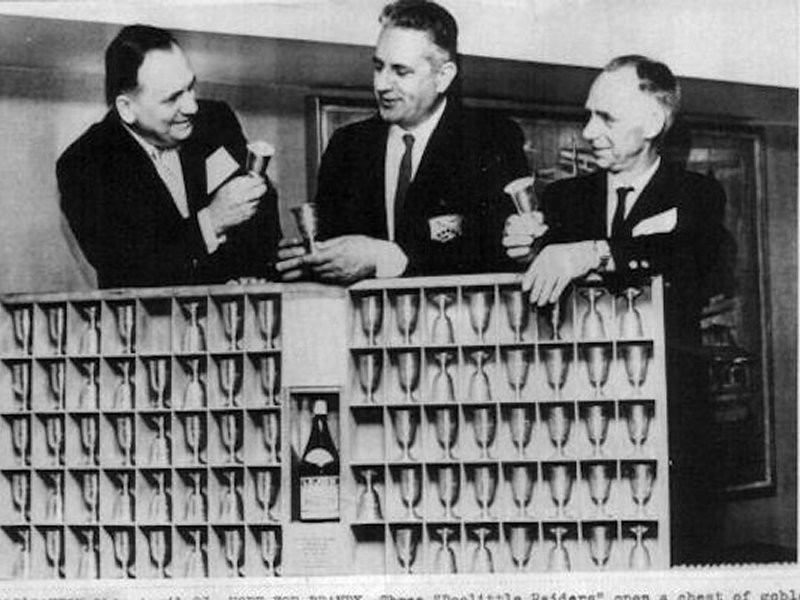
In 2013 in February, Tom Griffin passed away at age 96. What a man he was. After the raid, he bailed out of his plane over a mountainous Chinese forest. He became ill with malaria, and almost died. When he recovered, he was sent to Europe to fly more combat missions.
He was shot down, captured, and spent 22 months in a German prisoner of war camp.
The commitment and selflessness of these men, the sheer guts!
There was a passage in the Cincinnati Enquirer obituary for Mr. Griffin that, on the surface, had nothing to do with the war, but that was emblematic of the depth of his sense of duty and devotion:
“When his wife became ill and needed to go into a nursing home, he visited her every day. He walked from his house to the nursing home, fed his wife and at the end of the day brought home her clothes. At night, he washed and ironed her clothes. Then he walked them up to her room the next morning. He did that for three years until her death in 2005.”
Later in 2013, only four out of the original 80 remained. *** Cole (Doolittle’s co-pilot on the Tokyo raid), Robert Hite, Edward Saylor and David Thatcher. All were in their 90s. They decided that there were too few left to continue the public reunions. They decided to hold their last public reunion at Fort Walton Beach, Florida, not far from Eglin Air Force Base, where they trained for the original mission.
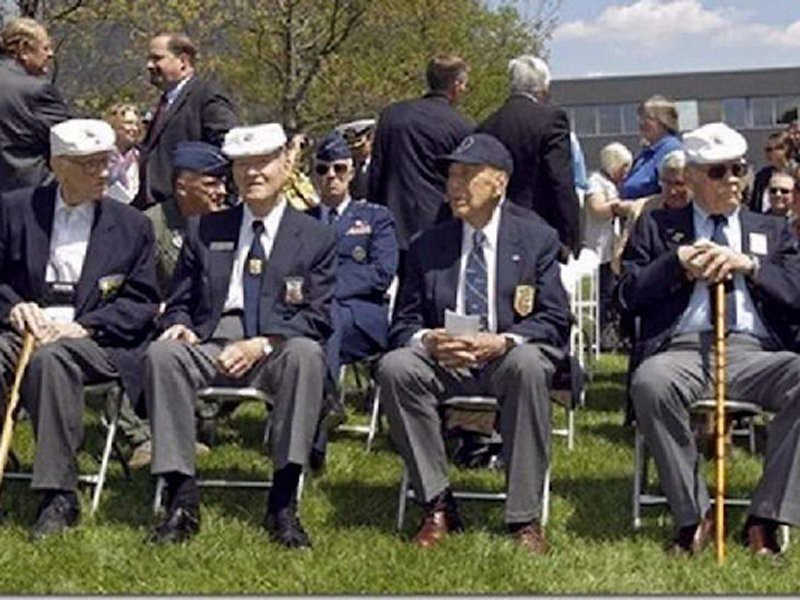
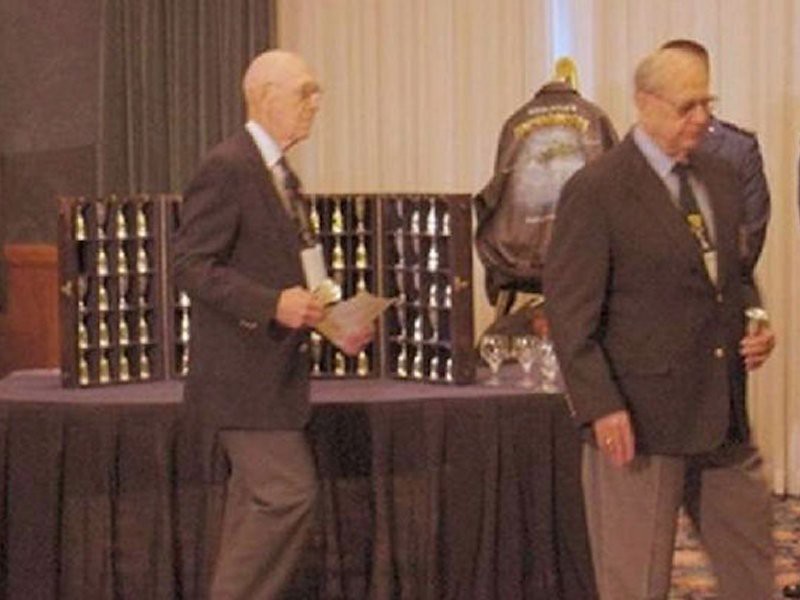
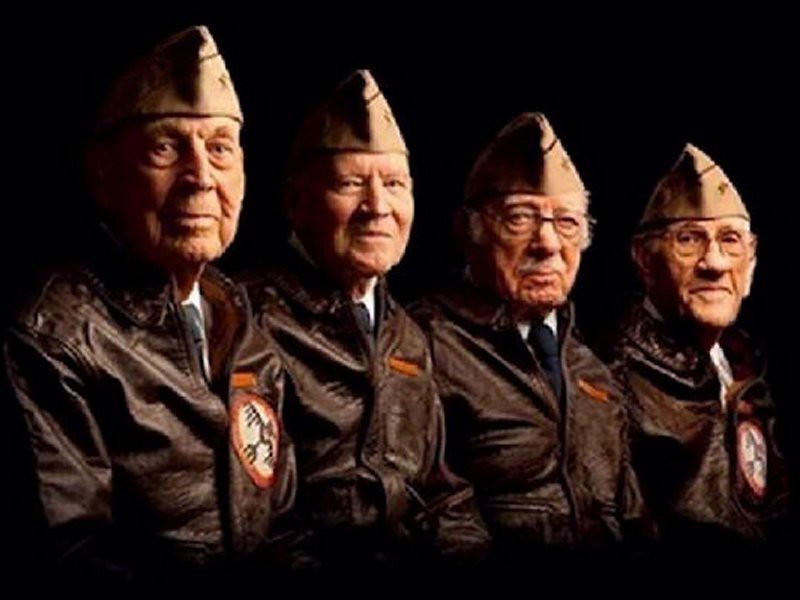
The events that year in Fort Walton Beach marked the end.
It had come full circle...back to Florida’s nearby Eglin Field where they trained in secrecy for the mission. The town did all it could to honor the men. It was a six-day celebration of their valor, including a parade in their honor. They decided, after that last reunion, to wait until a later date to get together once more, informally and in privacy to open the bottle of brandy.
With the years flowing by so swiftly, and with their health failing, the remaining men decided not to wait until there were only two of them before they filled the four remaining upturned goblets, and raise them in a toast to those who are gone.
That final toast "to fallen comrades," by three surviving raiders took place at the NMUSAF on 9 November 2013, preceded by a B-25 flyover. Richard Cole, Edward Saylor, and David Thatcher attended.
Did these men ever wonder if the rest of us, whom they sacrificed so much for, have taken care of the country in a way worthy of their sacrifice?
Well, if they did, they didn’t talk about it...at least not around others.
As to the bottle and the goblets? Well, they were maintained by the United States Air Force Academy and displayed in Arnold Hall until 2006, taken out each year for the celebration and reunion. Then in April 2006, they were transferred to the National Museum of the United States Air Force at Wright-Patterson AFB, Ohio, where they were taken out each year until that final toast in 2013.
Sadly, Edward Saylor, the engineer/gunner of aircraft No. 15, died January 28th, 2015 at his home in Sumner, Washington. Having been born in March 1920, he was 94 years old at the time, just less than three months short of his 95th birthday.
God bless them all...and God grant that we, in our turn, can be as committed to, and willing to stand up for liberty, as they were.
The Merit International Model and the add on kits and additional Aircraft I purchased<?font><?b>:
In 2012 I purchased the Merit Internation completed model of the Hortnt.
It included only 12 pre-built and painted B-25s, and the model itself, all plastic, was also completed.
So I purchased the detailing kits to add railing, sensors and other details from Tom's MOdels and Gold Medal Models. I also purchased more Trumpeter 1/350 scale B-25s so I could complete the model with all 16 B-25s on deck.
The model is decent. it is well done and to get it for around 100.00 like I did was a fair price for a completed model.
Here's how what I pucrchased looked:
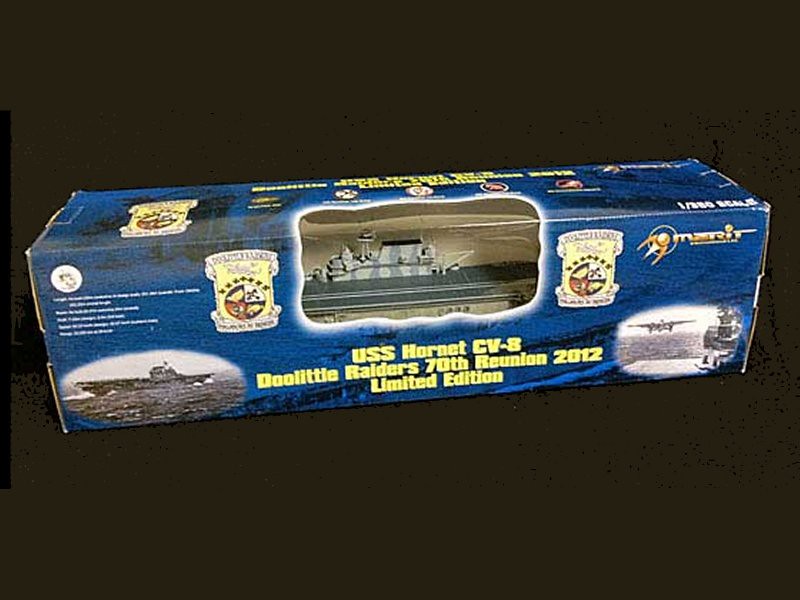
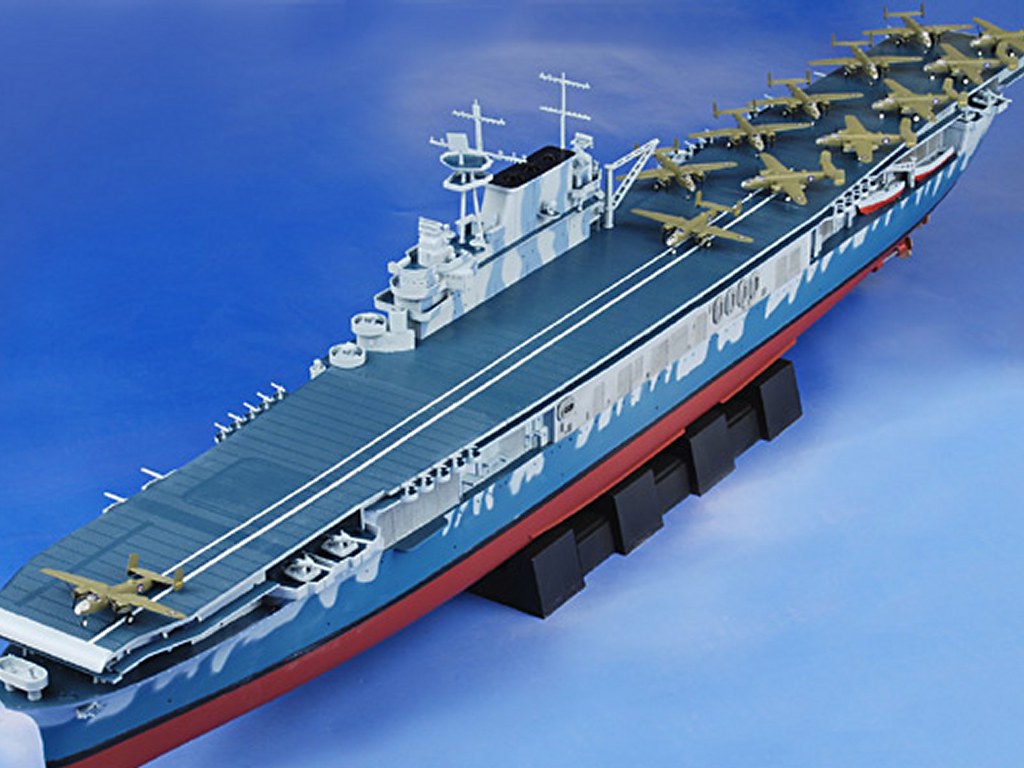
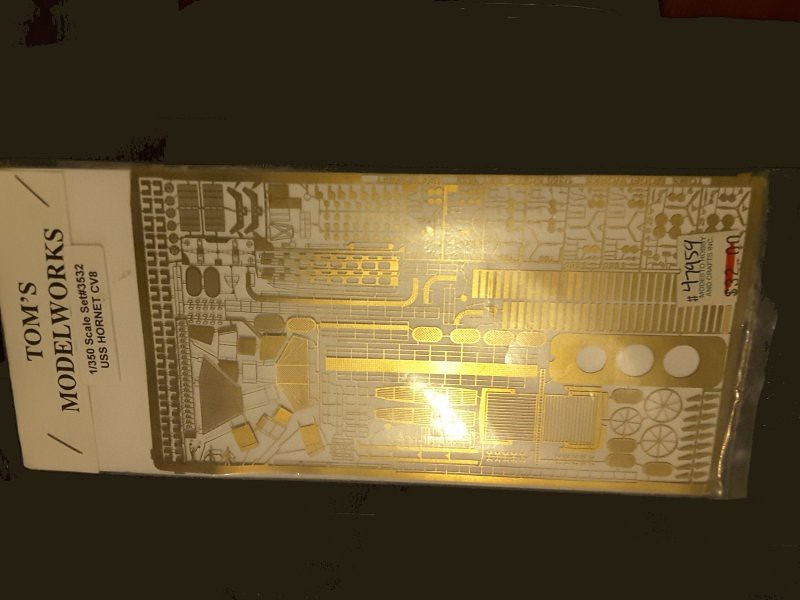
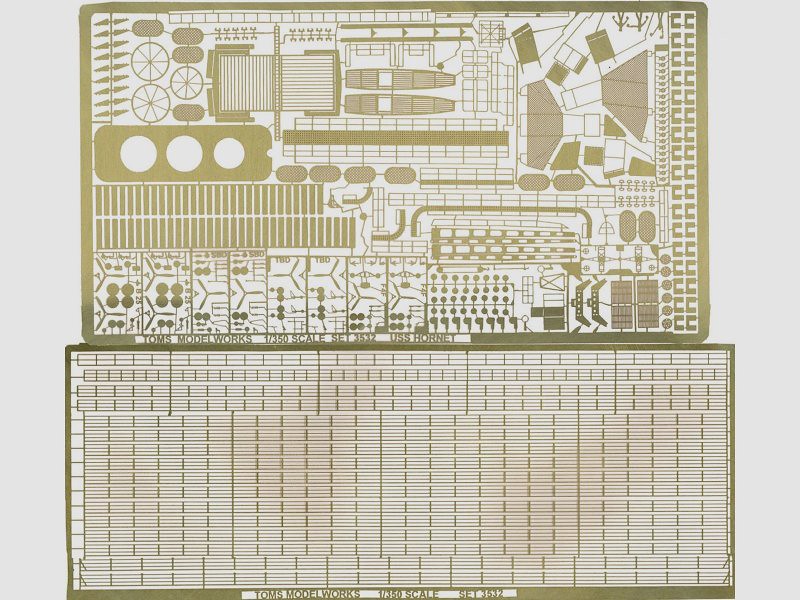
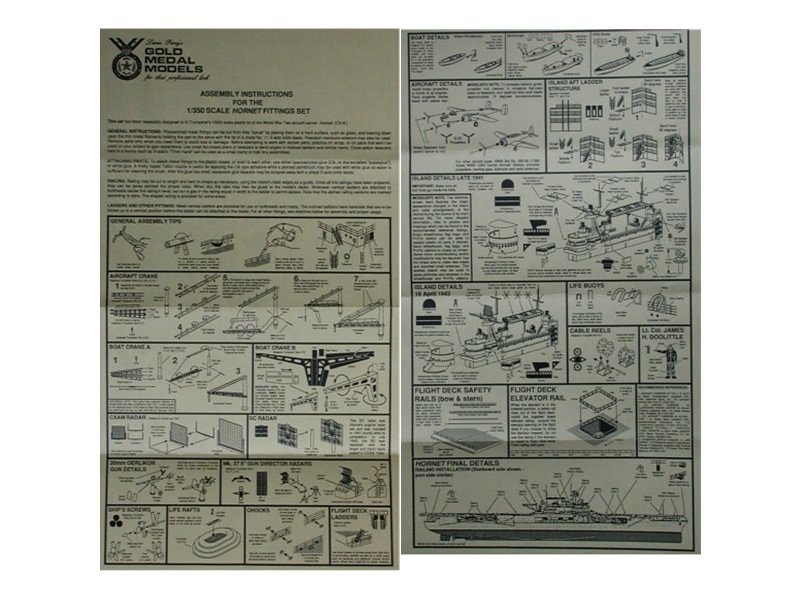
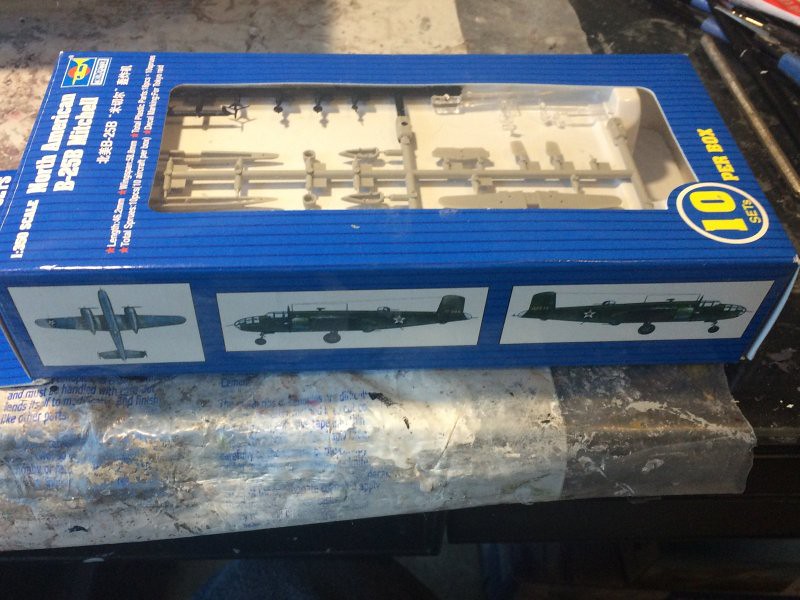
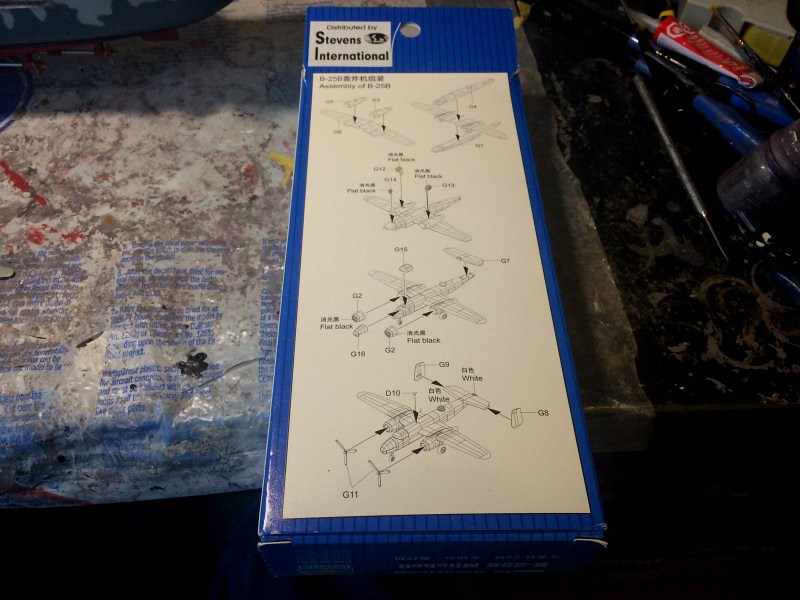
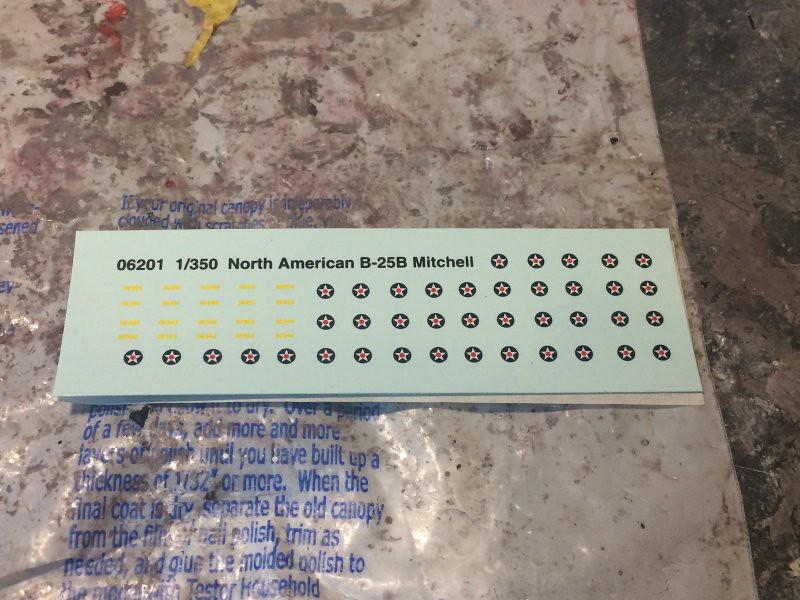
This was all in 2012. My intent is to build the Hornet, the Enterprise, two destroyers from the taks for ce and one cruiser.
I started by completing the Hornet, this review and build.
The Build - Adding the Detail, Photo Etch kit: - February 20, 2017
The Kits contain a lot of detail. I added all of the railing, the LSO decks fore and aft, ladders, and numerous others details as included in these kits.
Here's how that looked, over a several day period.
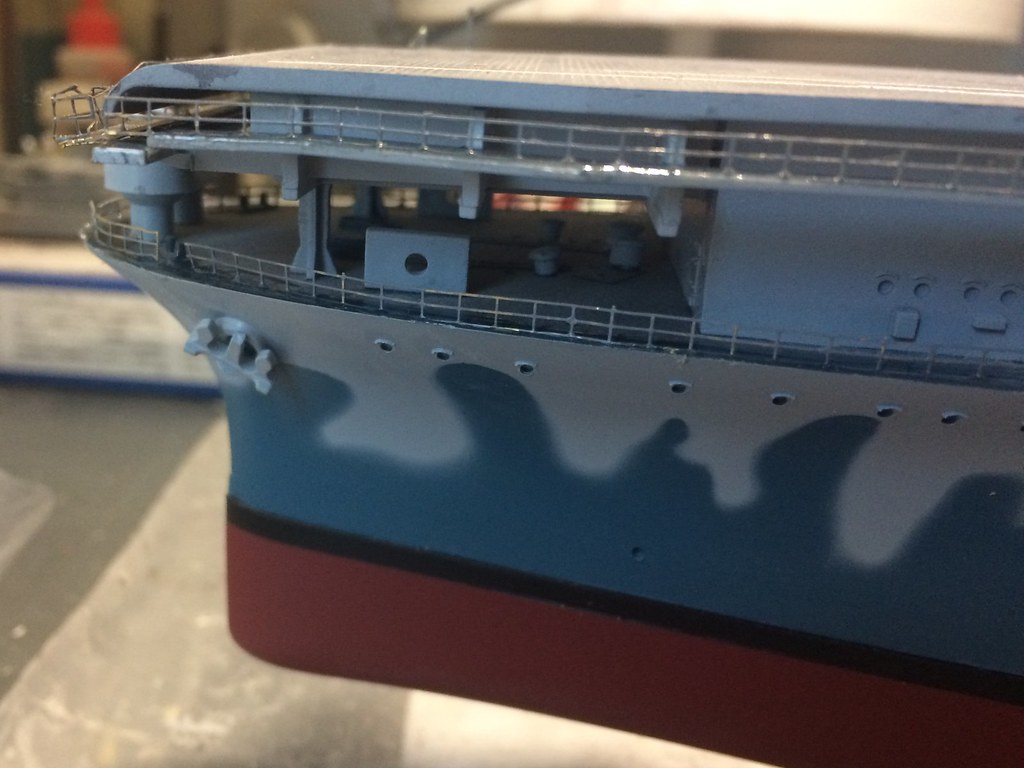
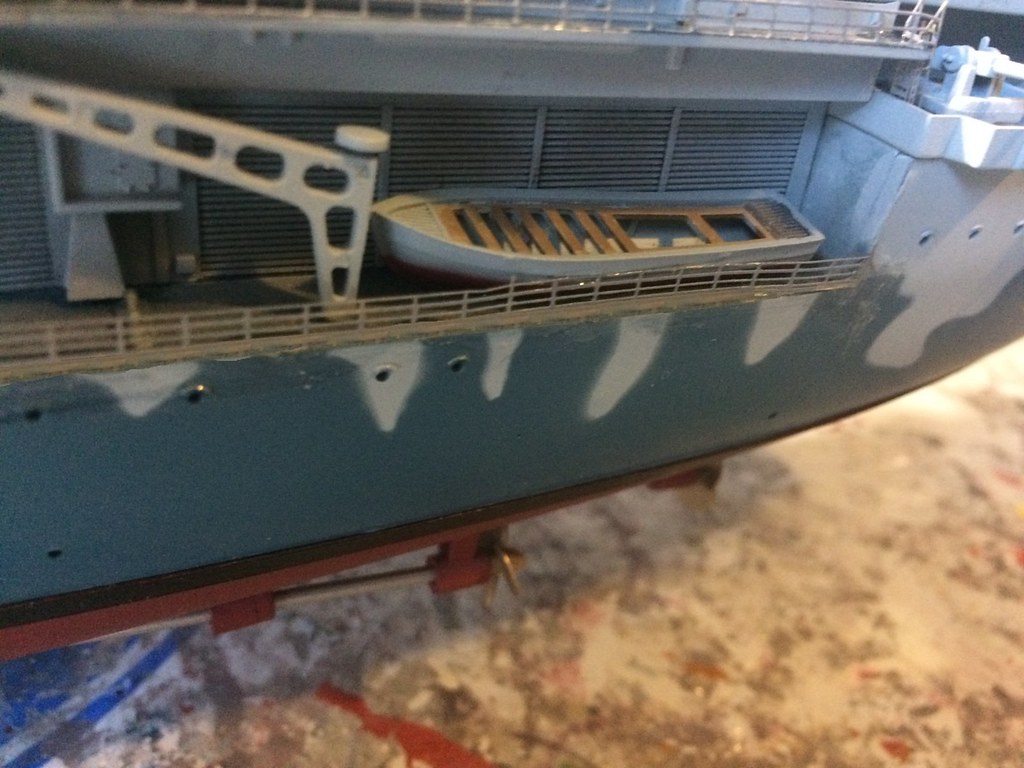
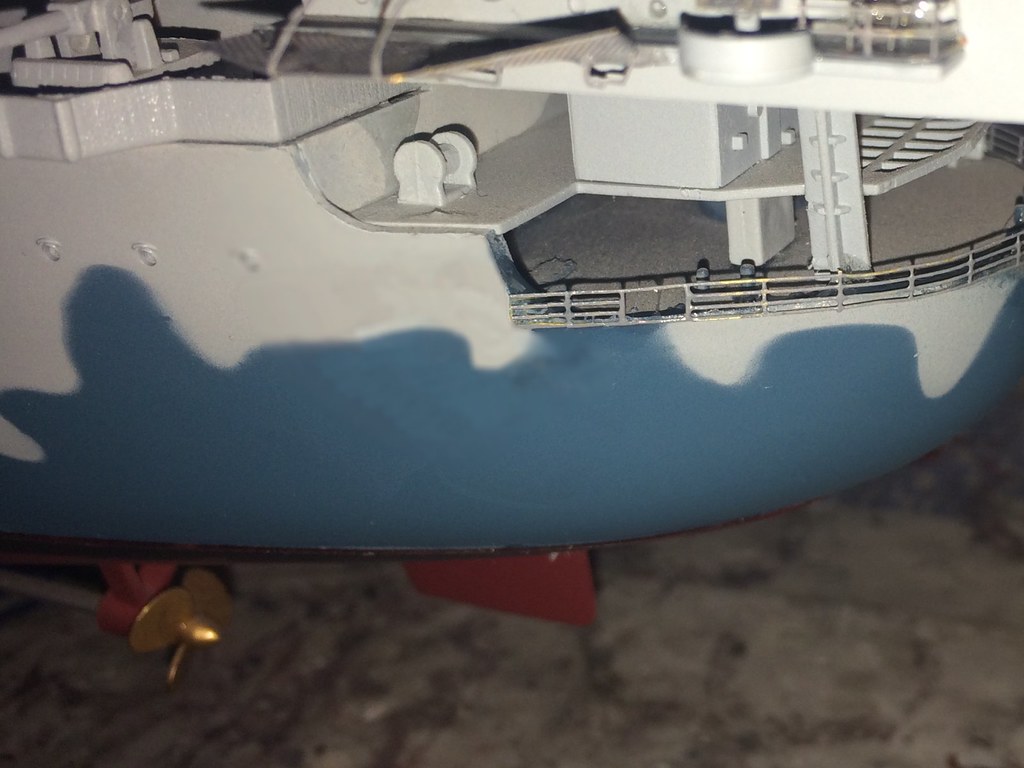
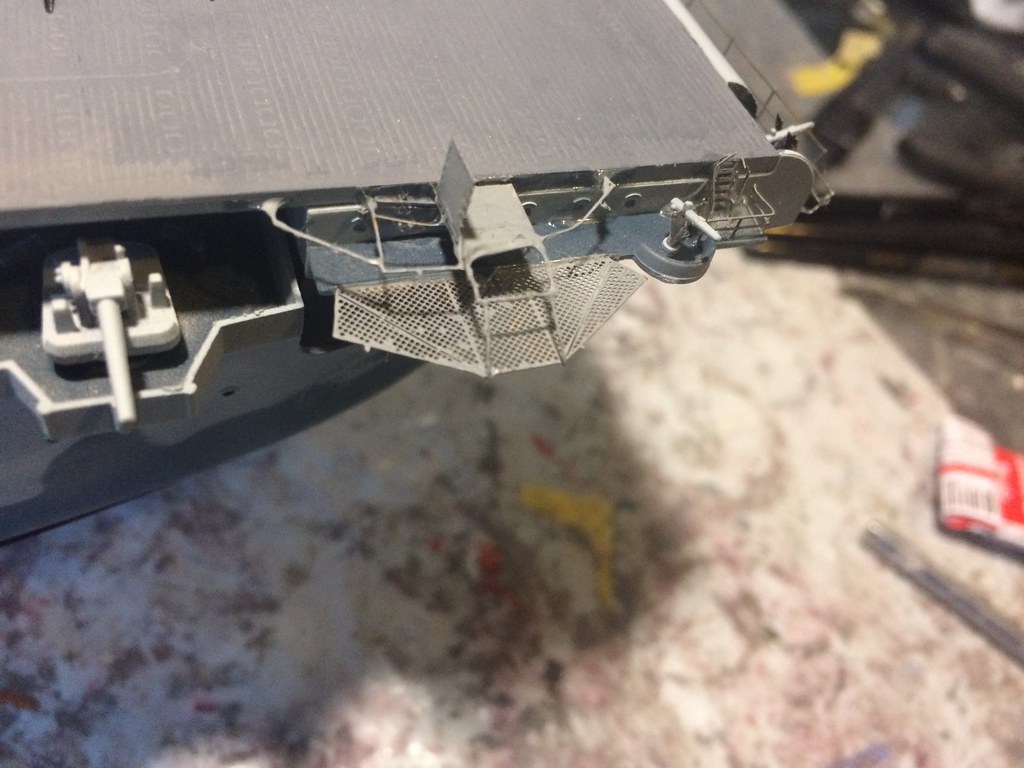
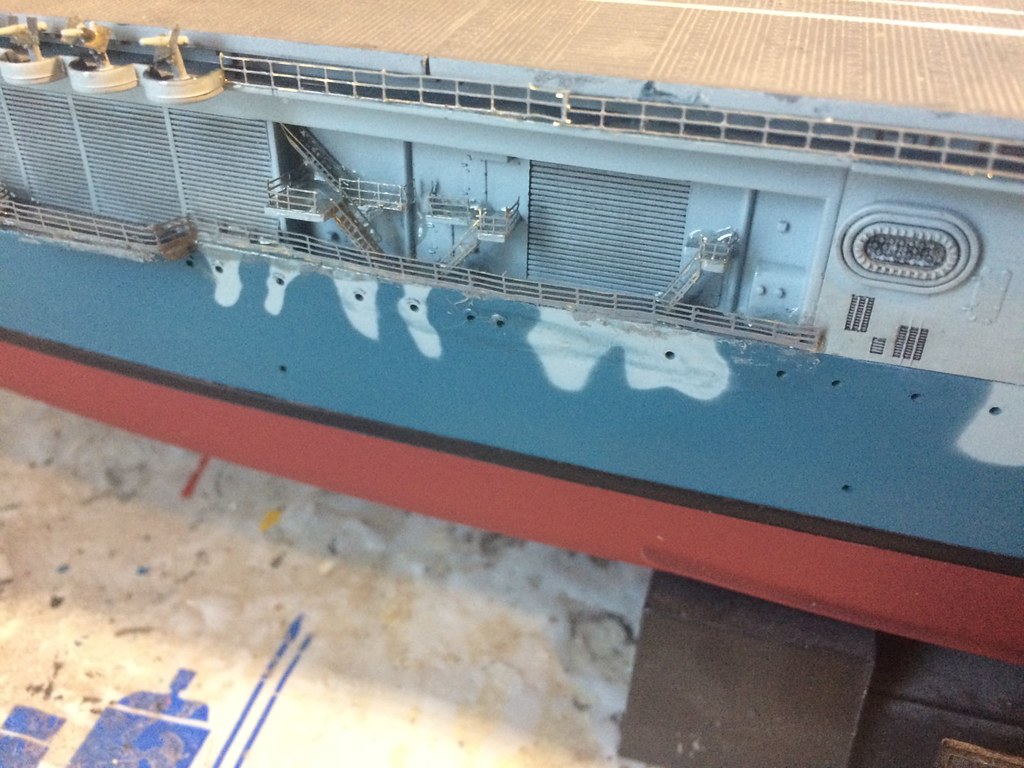
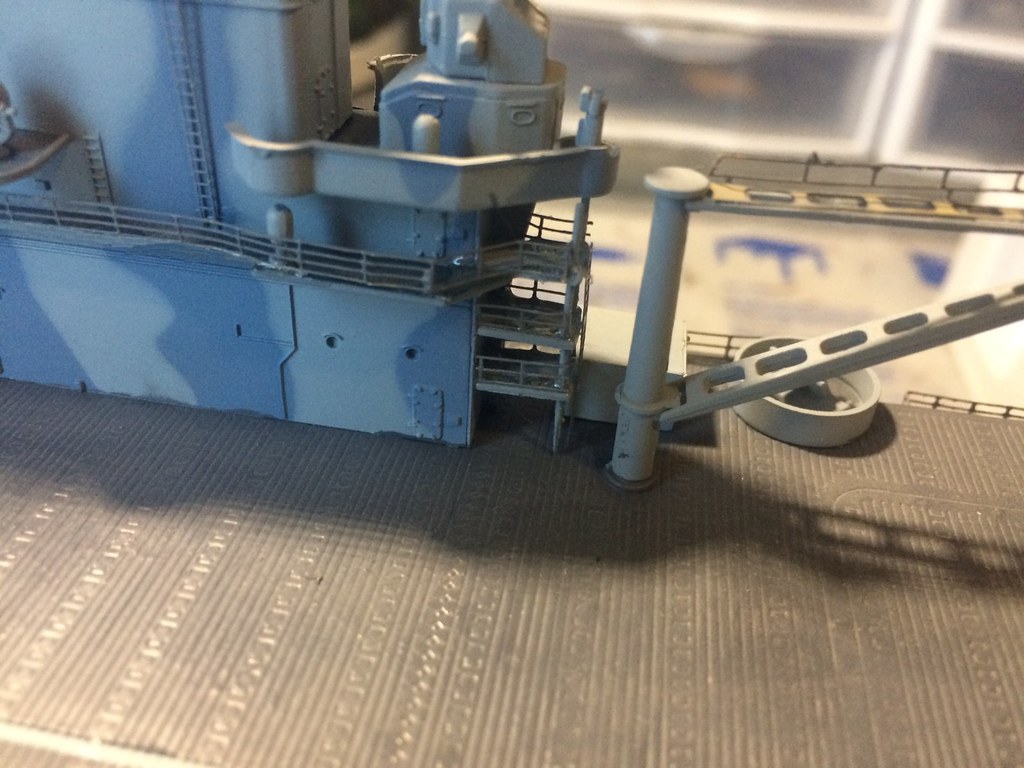
This dressed her up pretty nicely.
The Build - Touching up the aircraft and adding the new aircraft: - February 24, 2017
Over the last four years, the twelve aircraft that came with the model have suffered somewhat, so I had to work on them to fix broken geaar, props, etc.
I then built out the Trumpeter aircraft. They come in a box of ten and I used four to get my total count up to 16.
each is a miniature kit itself containing about 18 pieces. I built them and then matched the coloring, whih was basically Testors flat Olive Drab with a slight amount of flat light green light green mixed to match the upper side, and then Model Master Flanker Pale Blue to math the lower surfaces. Add the white to the inner portion of the wheels and you have a very good match.
Here's how that looked:
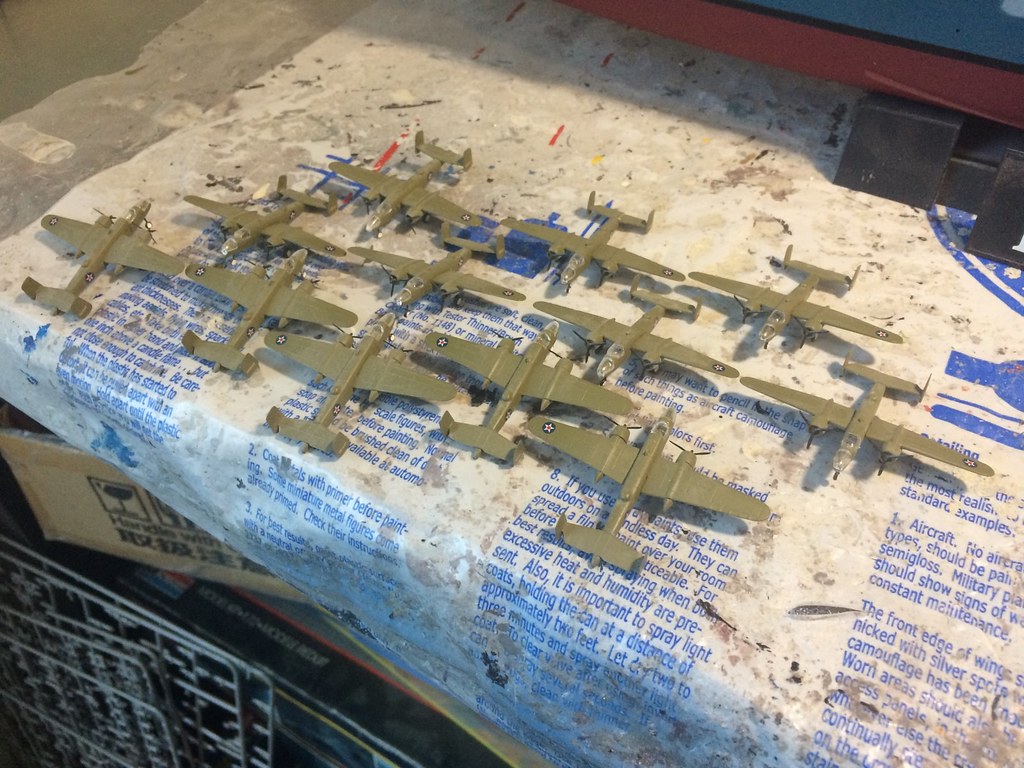
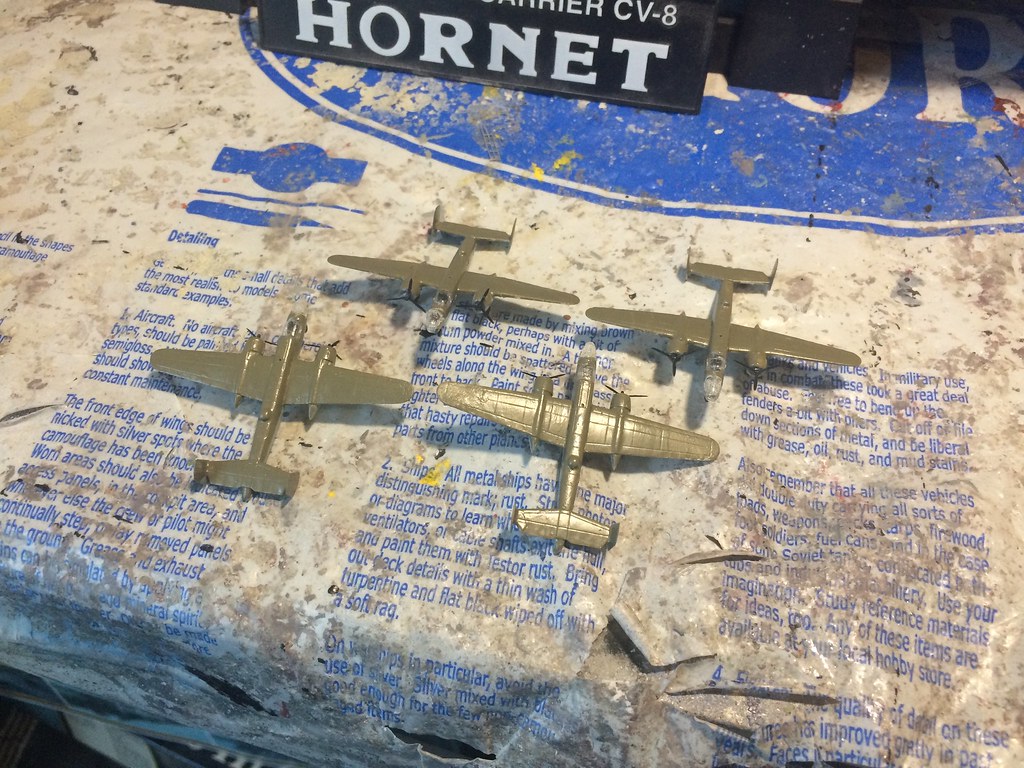
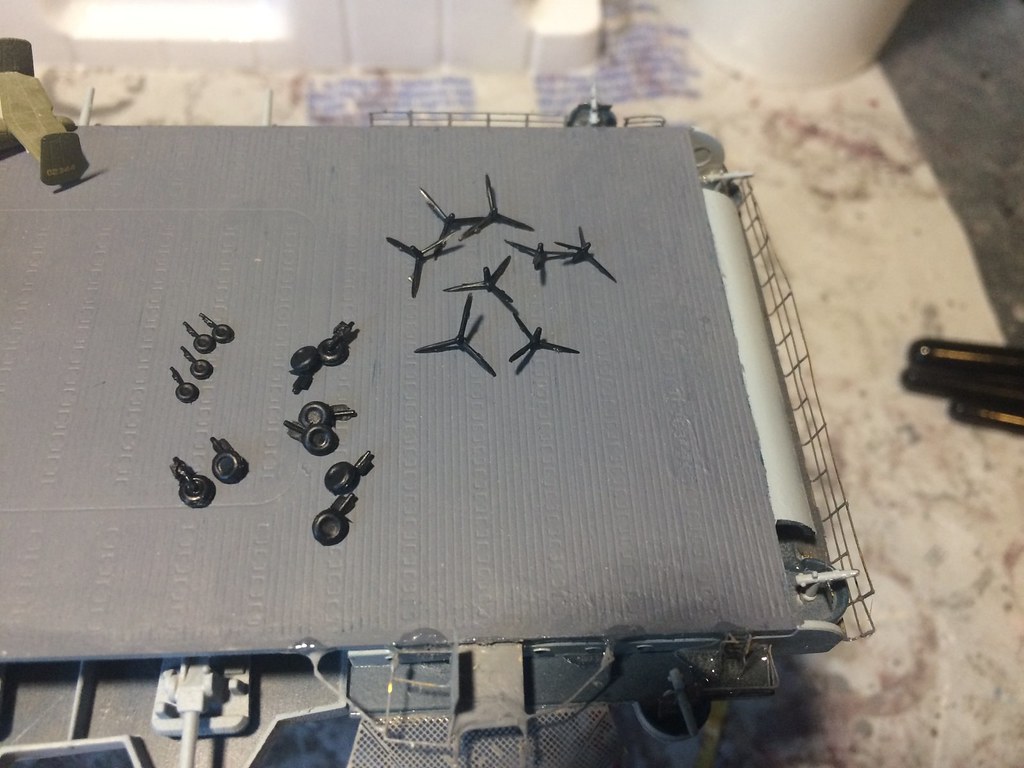
The Build - Adding the aircraft to the vessel: - February 25, 2017
Then it was time to add the aircraft to the deck.
I have the first aircraft (Doolittle's aircraft), approaching the end of the deck and take off, withthe second aircraft lined up at the aft end of the island.
The other 14 aircraft are then lined up on the port and starboard side as seen in the pcitures.
Here's hw she looked when that was complete.
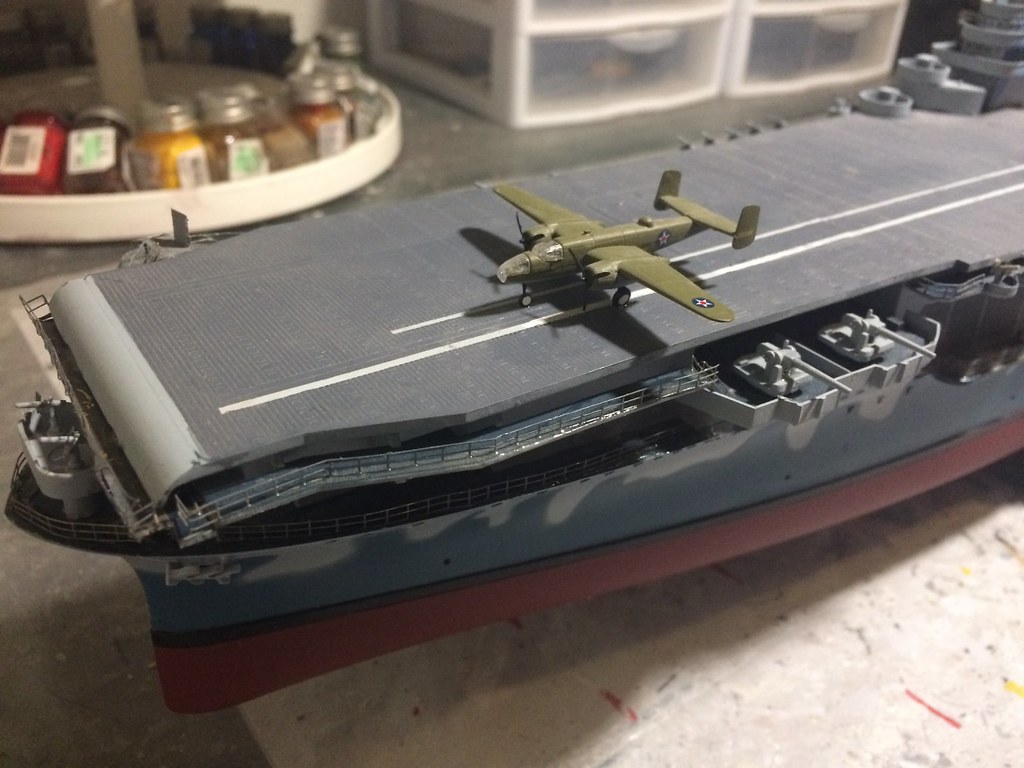
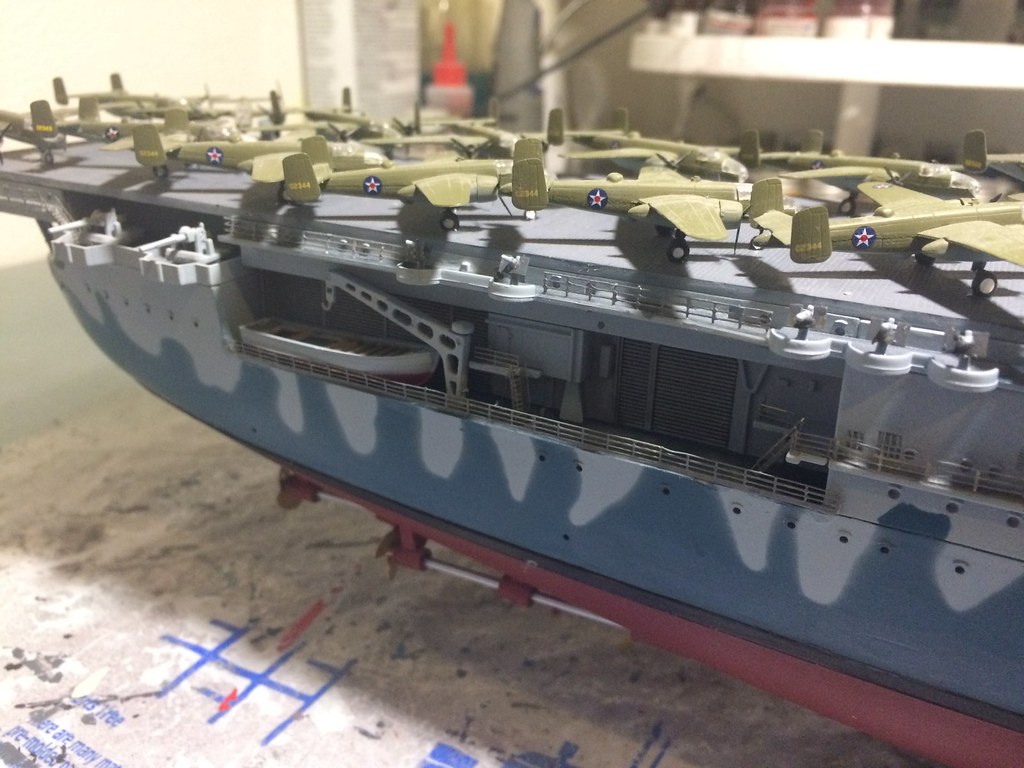
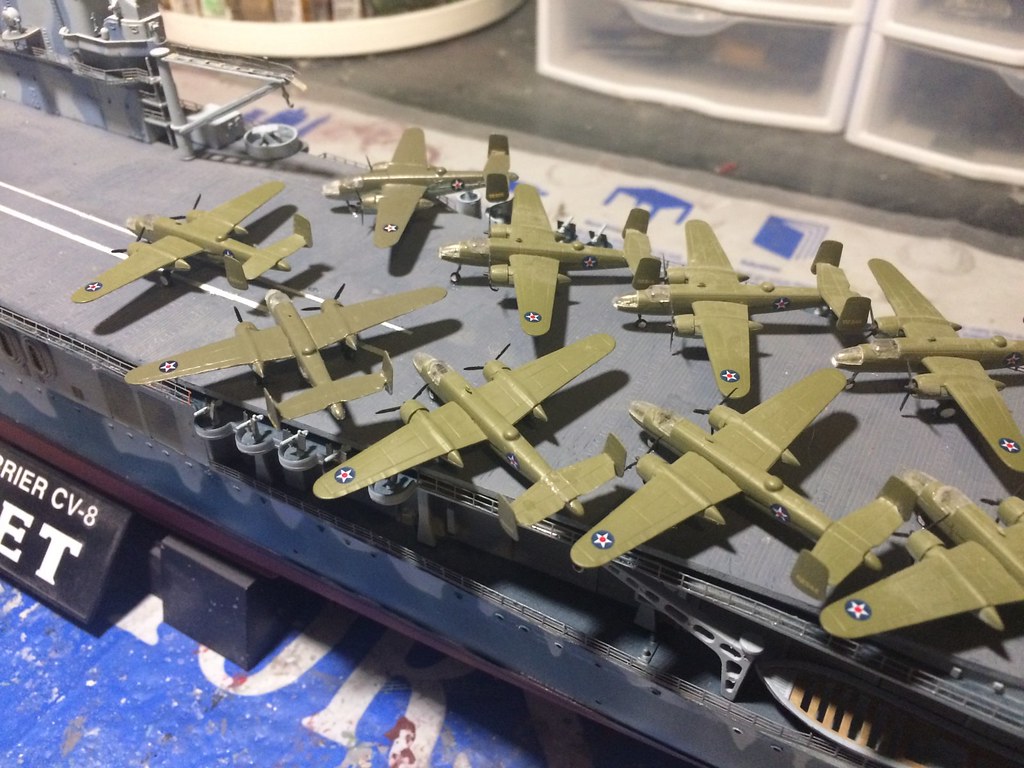

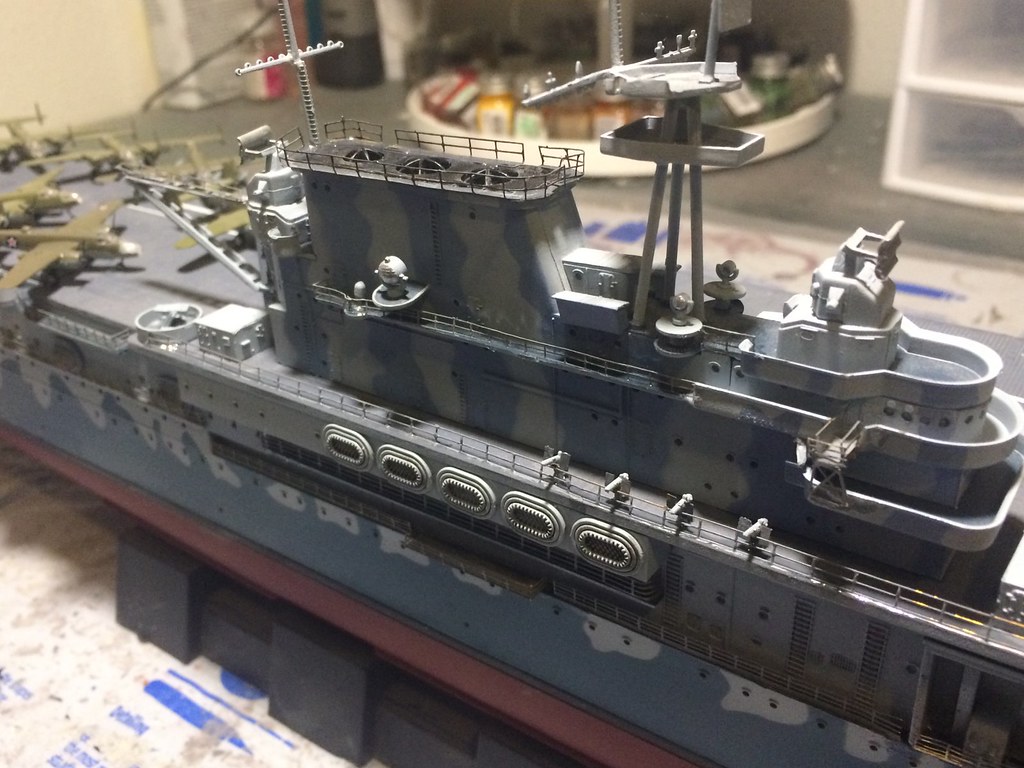
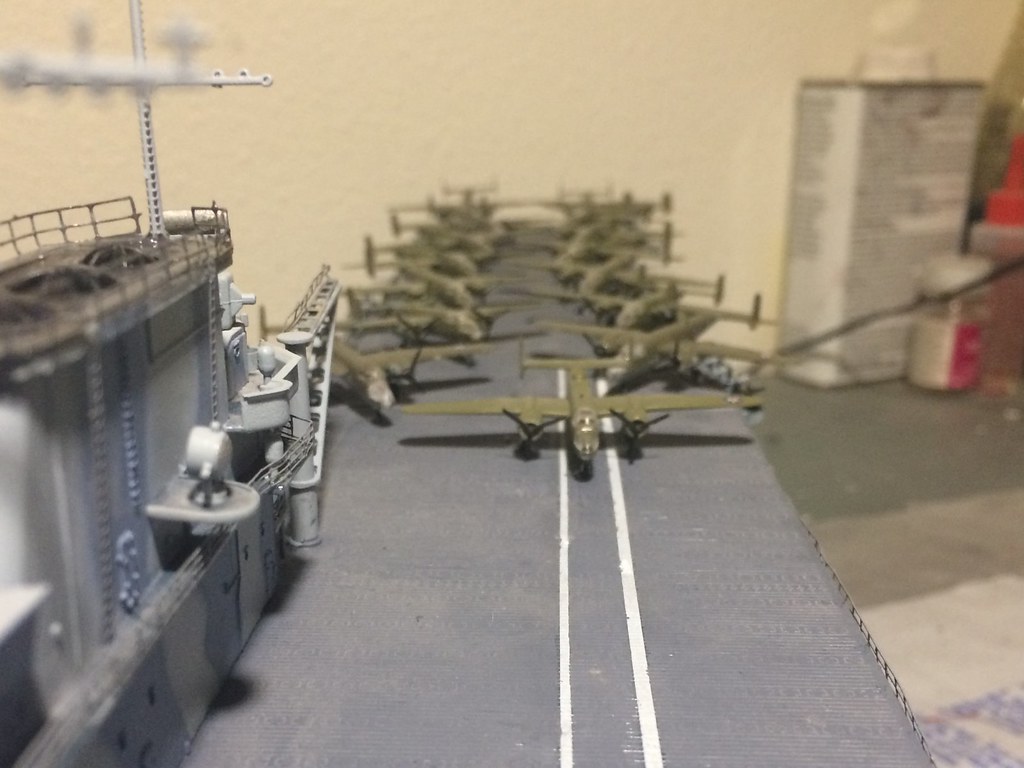

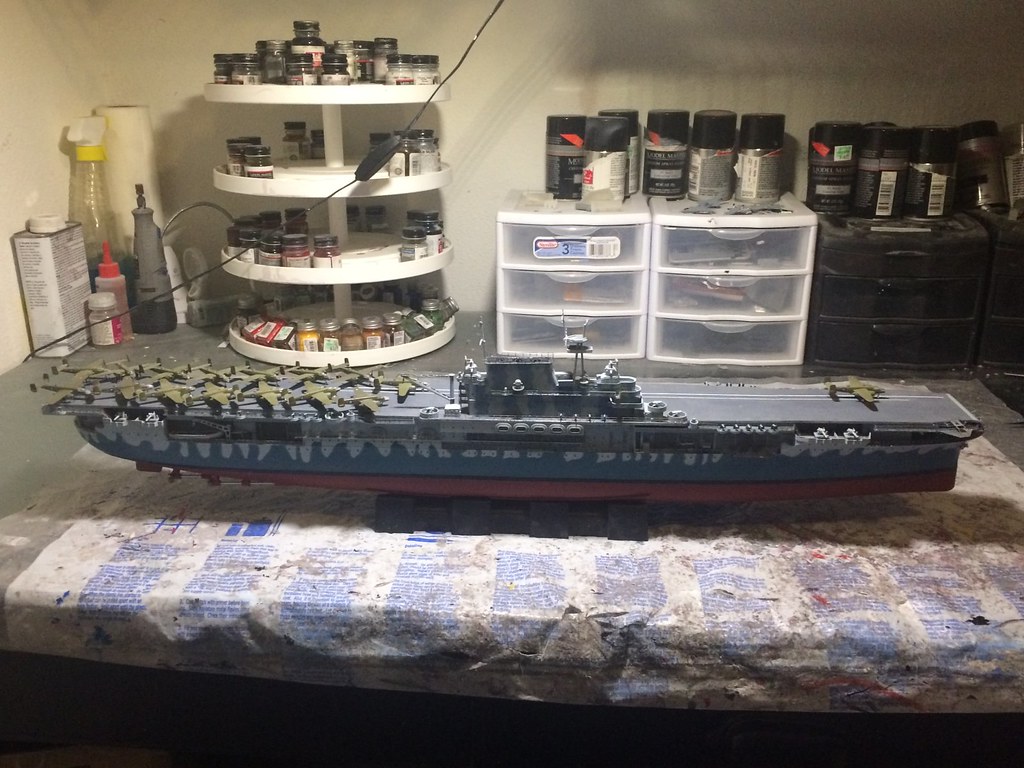
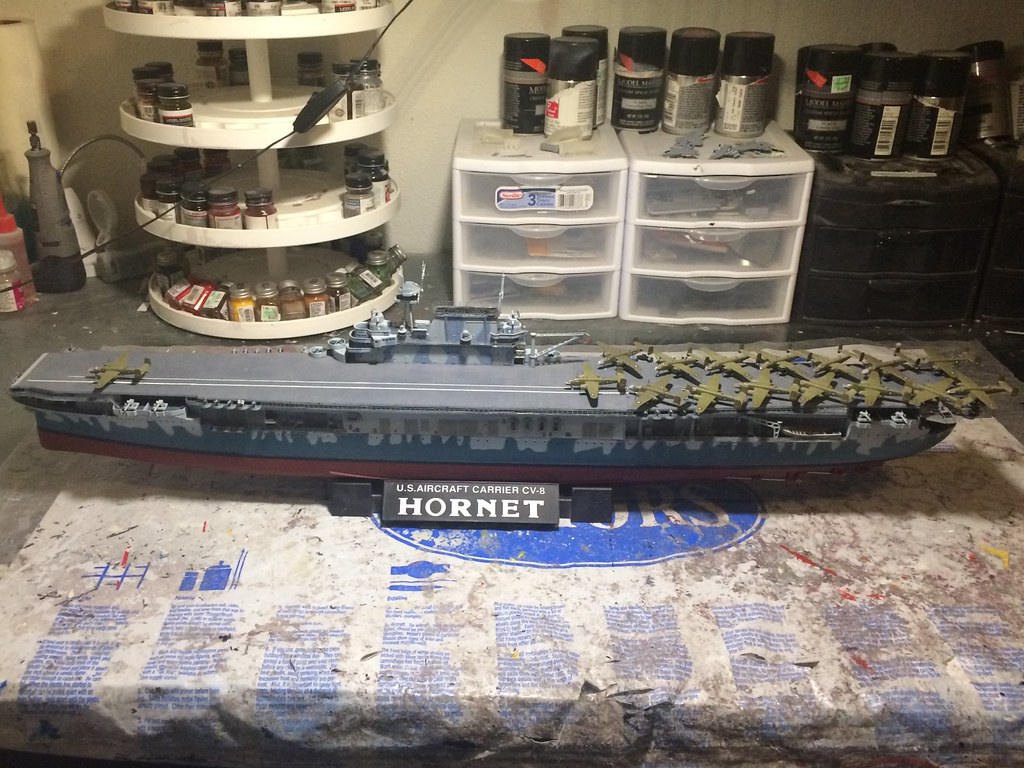
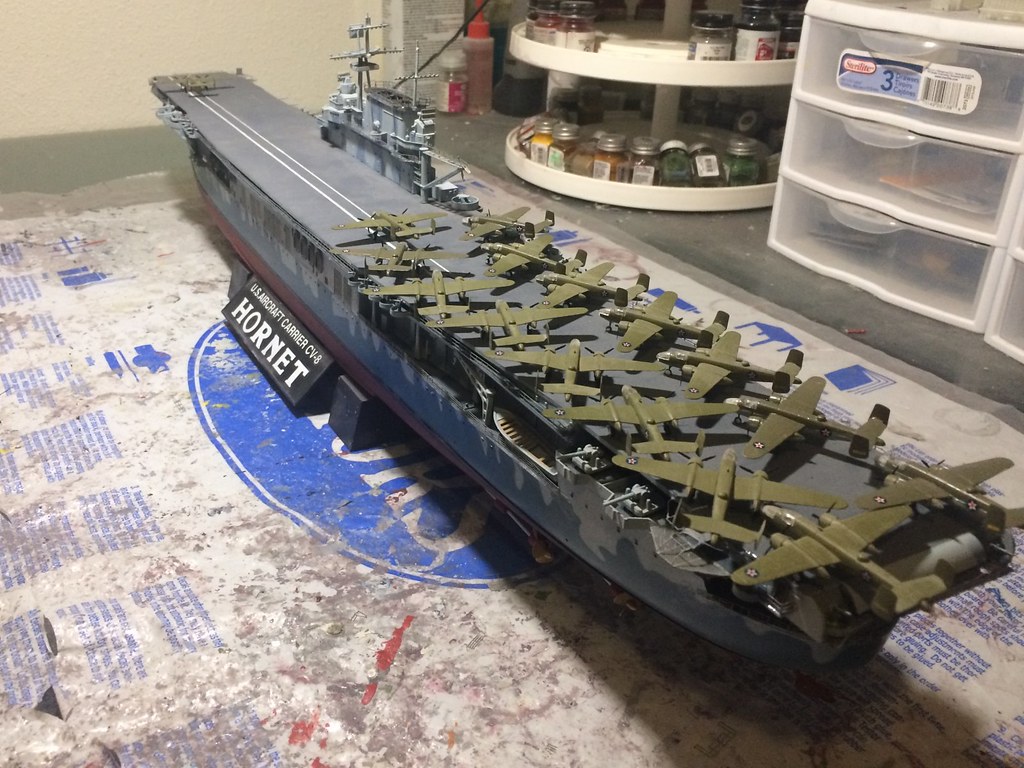
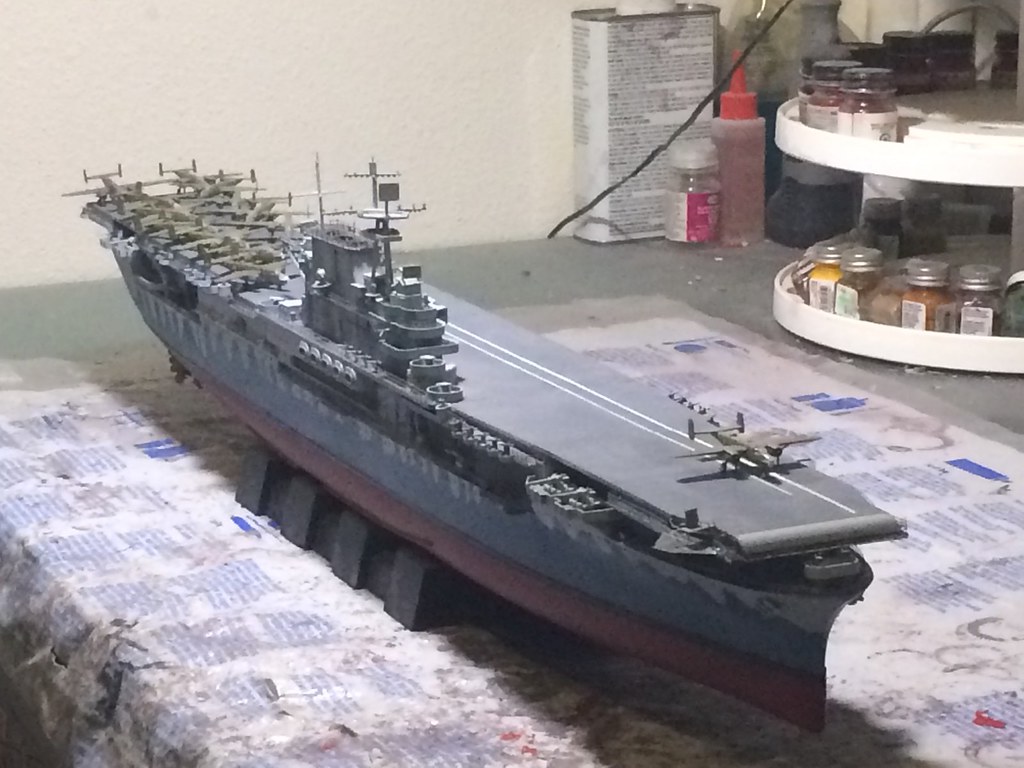
She is looking very nie here.
The Build - Final Touch up and completion: - February 27, 2017
I then needed to do some touch up on the paint, ass the dull coat finish, and then take the final pics. Here's how all of that looked in completing this model:
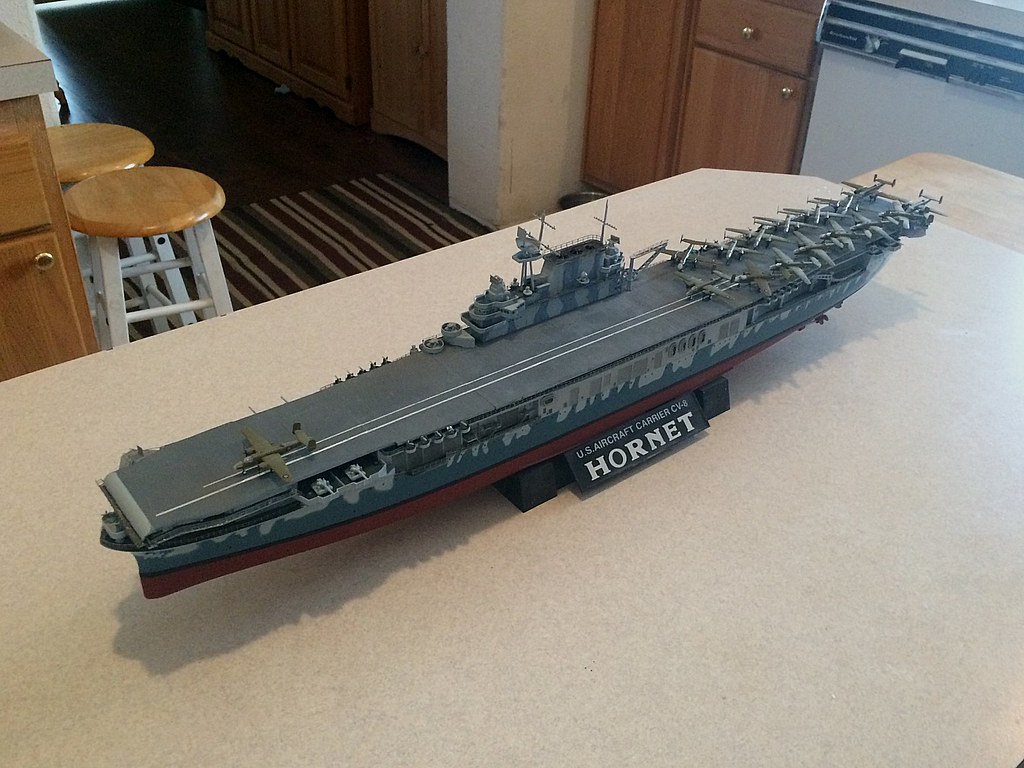
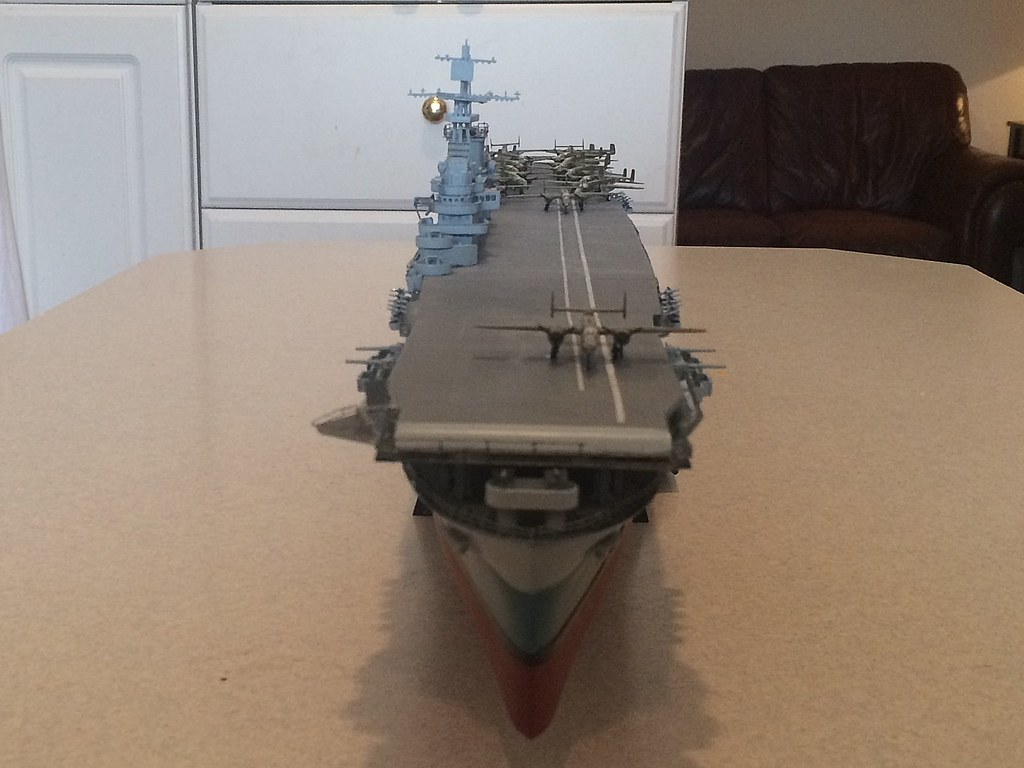
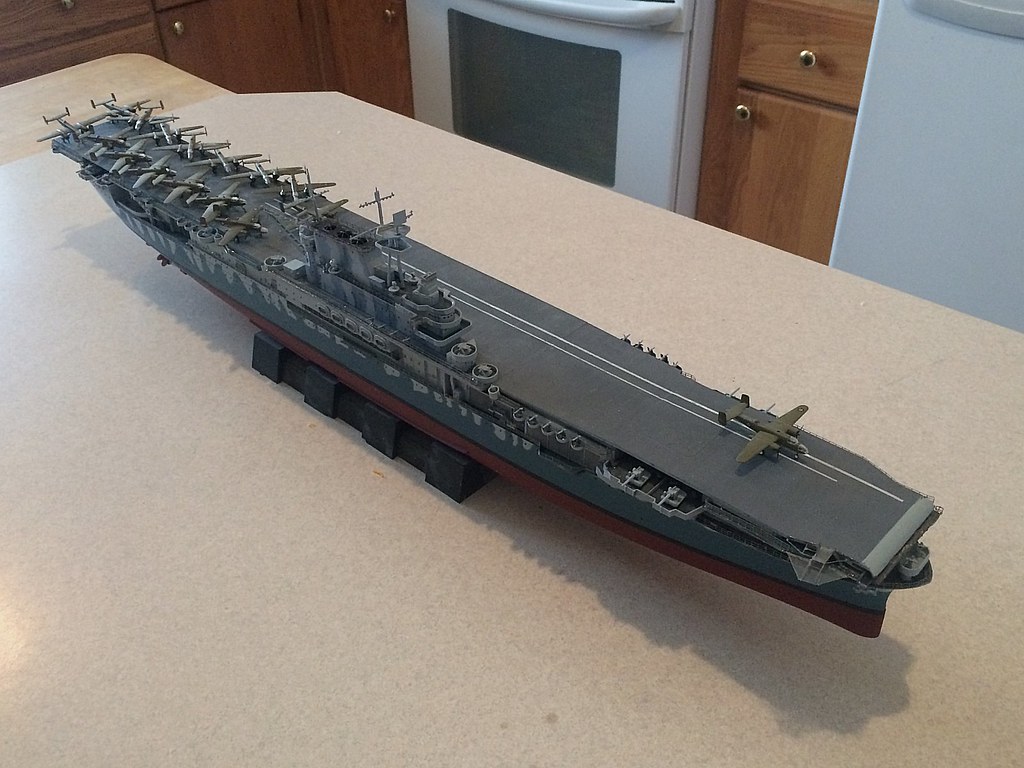
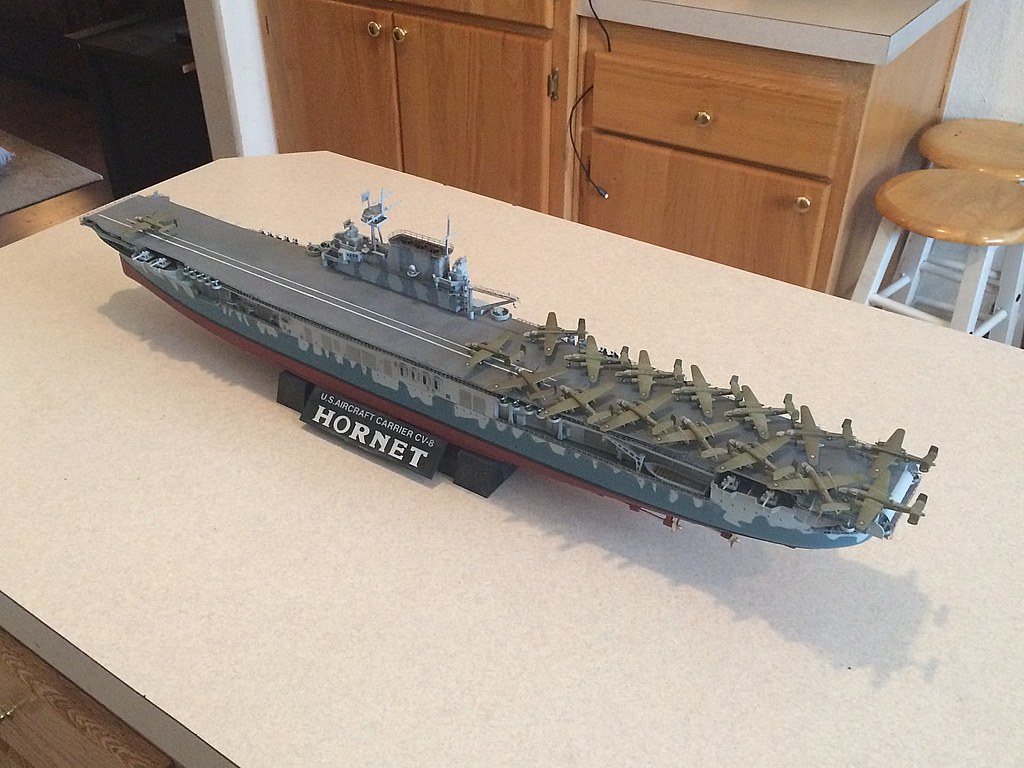
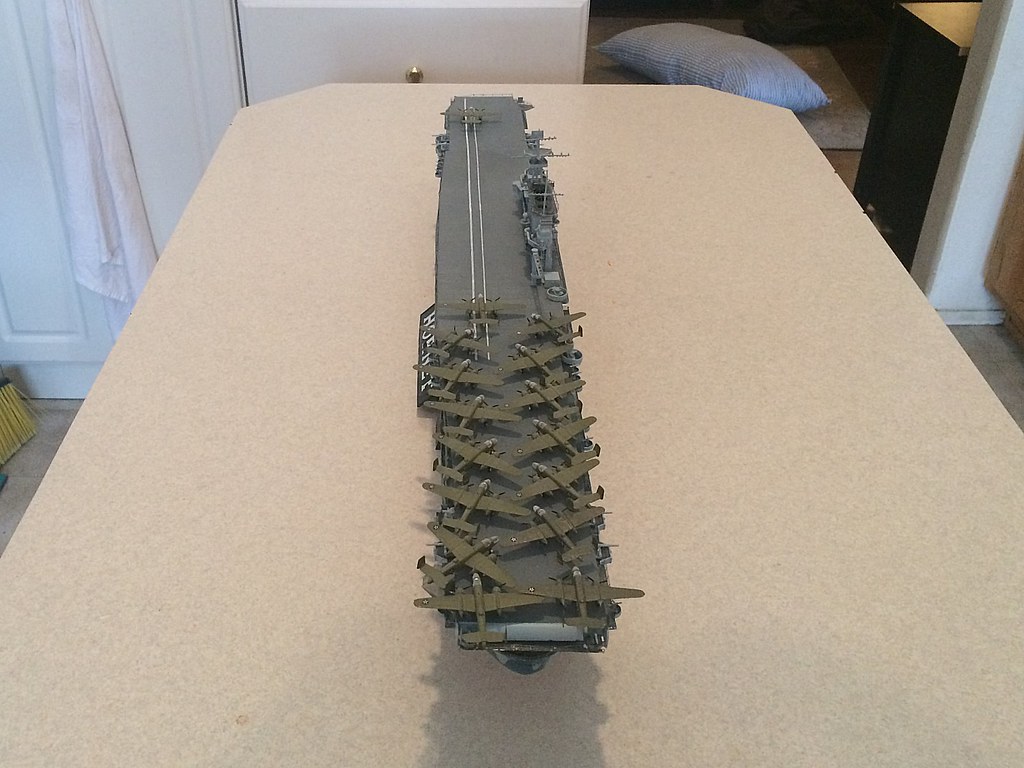
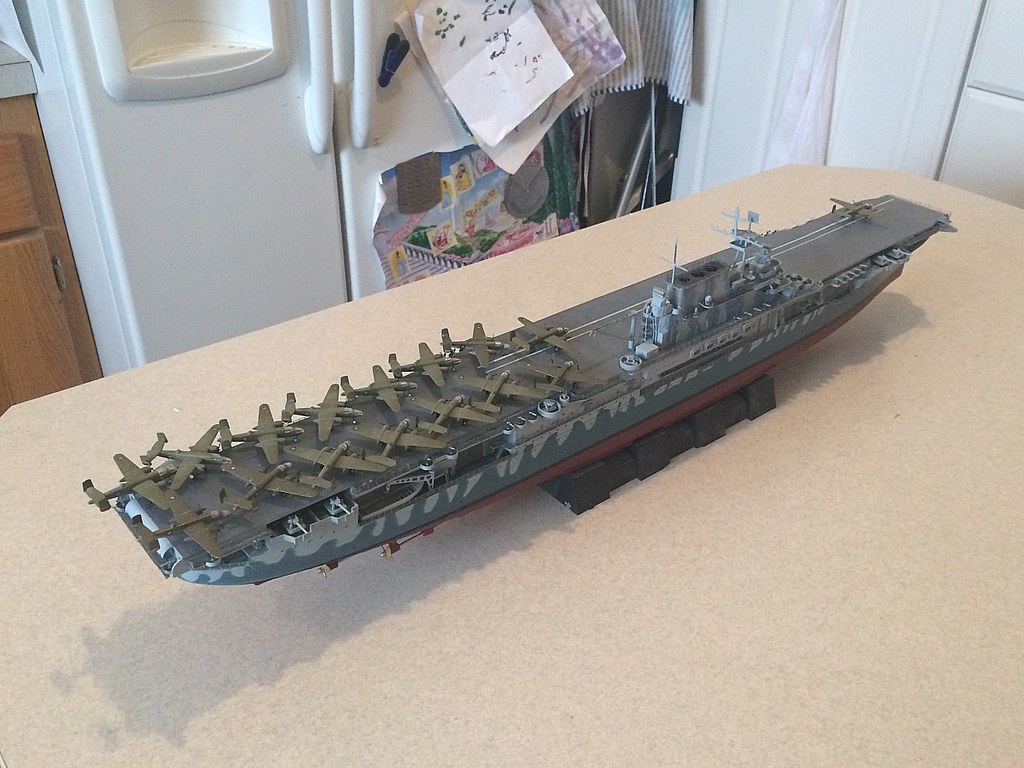
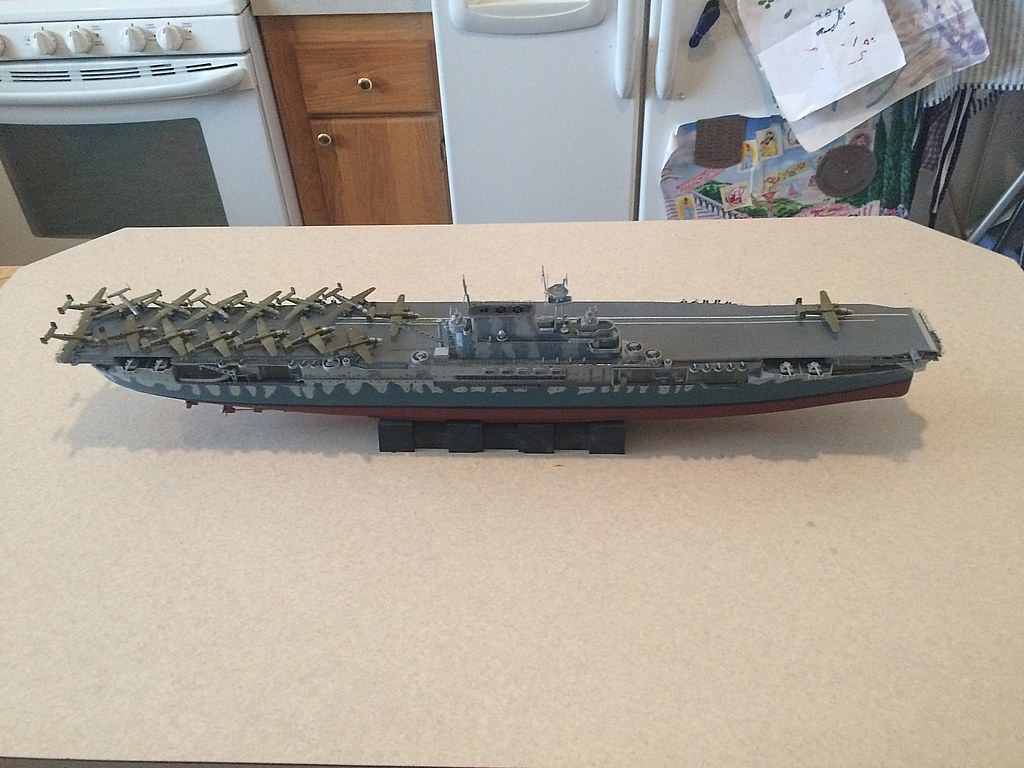
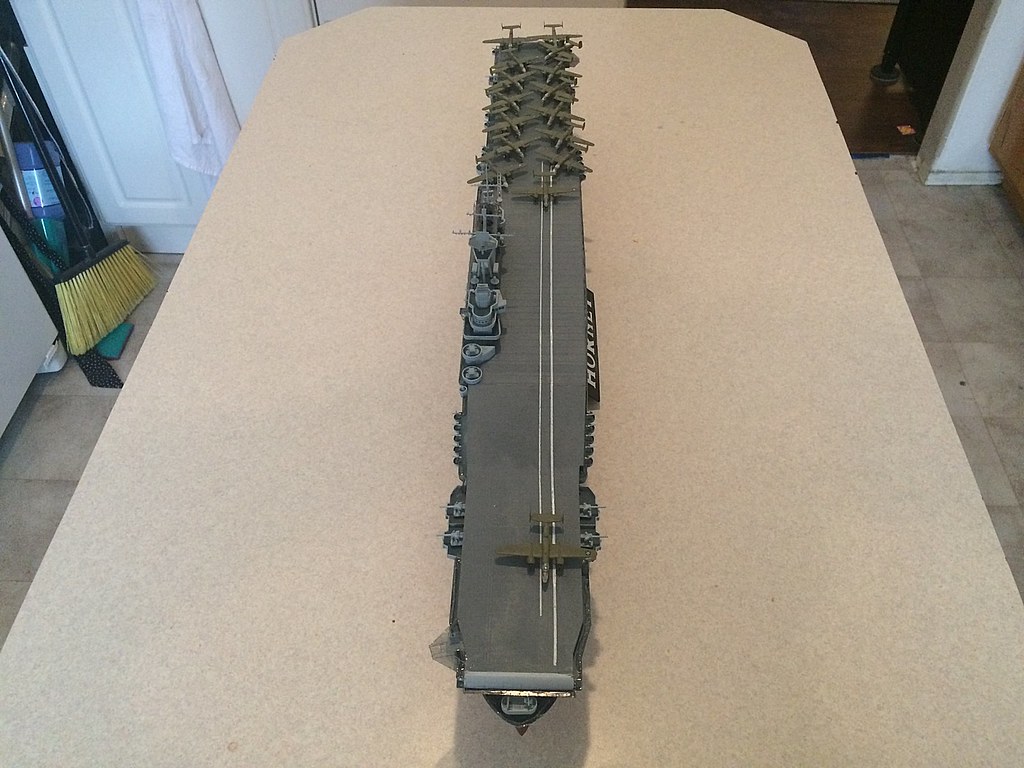
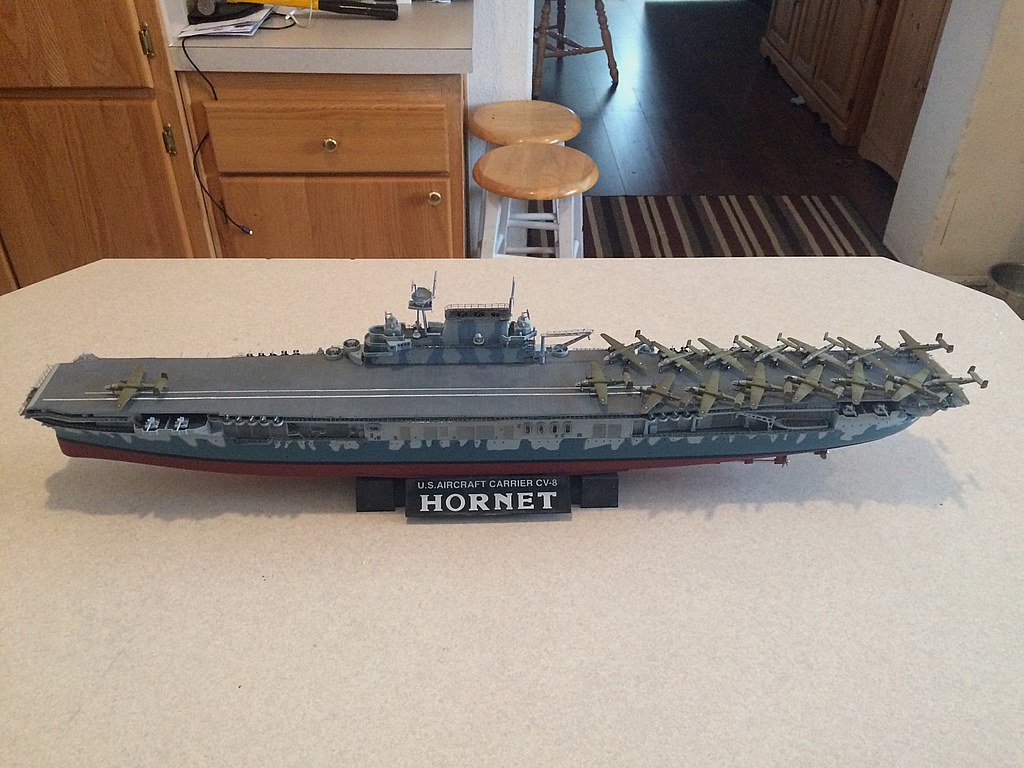
...and some close up shots:
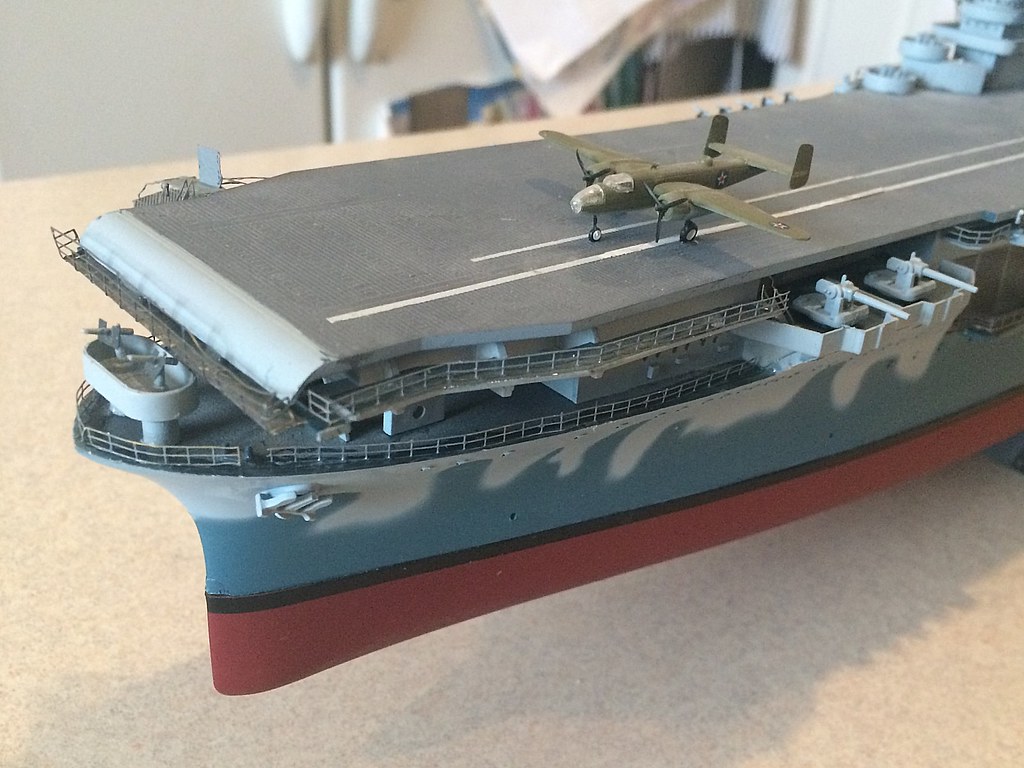
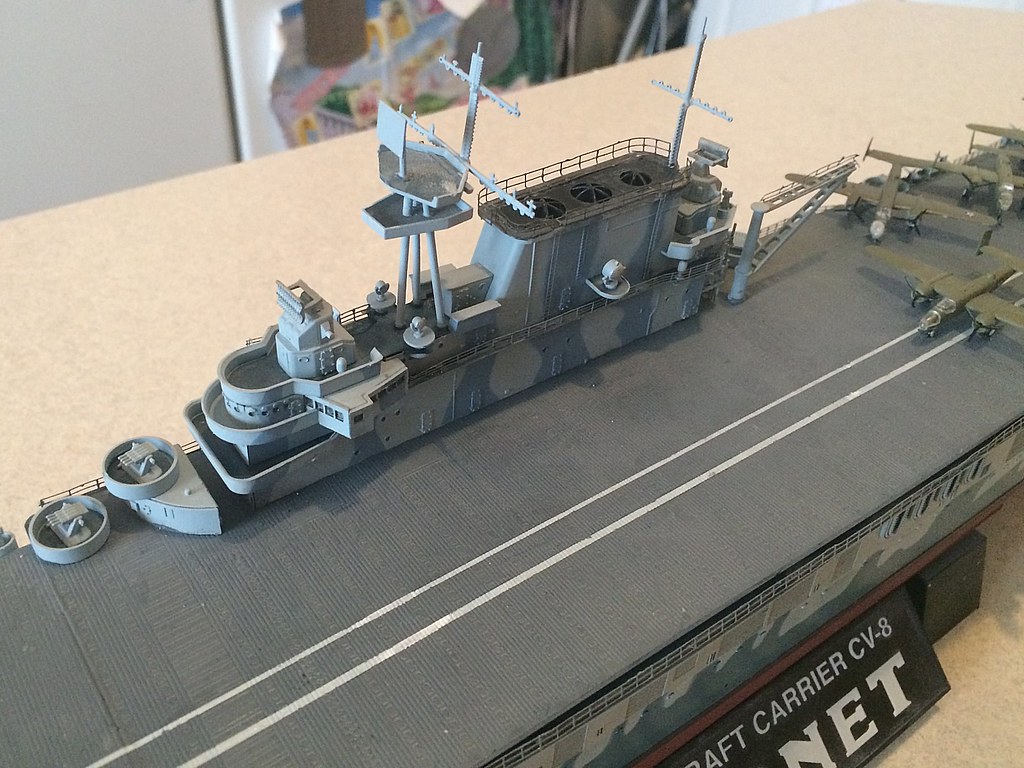
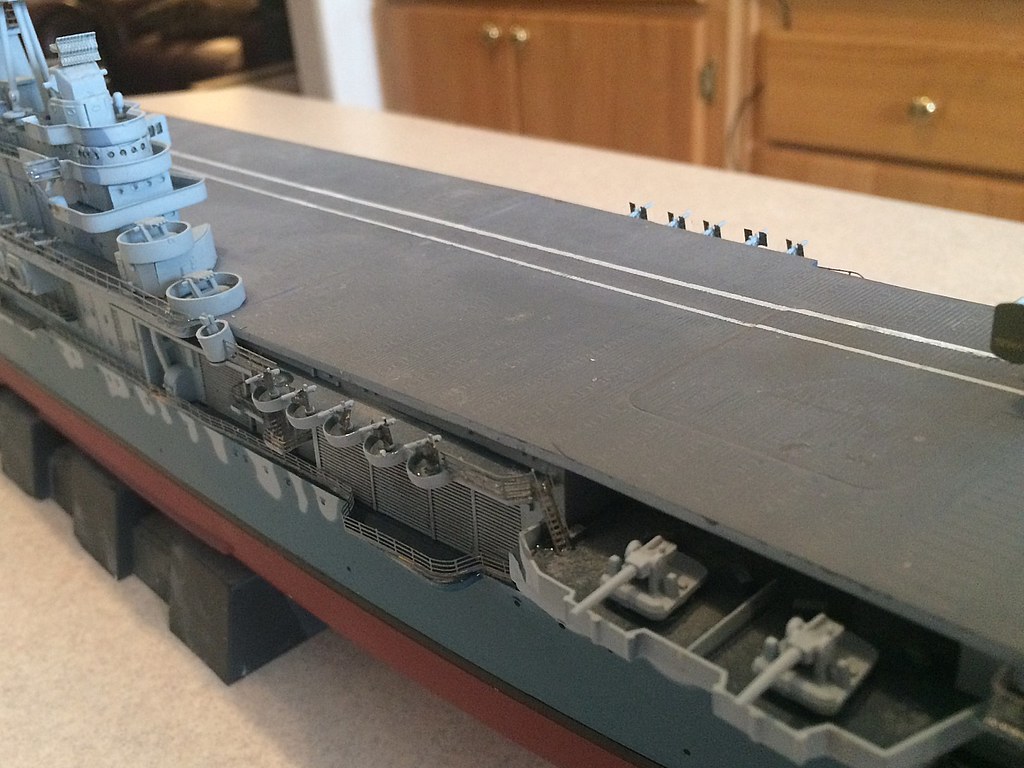
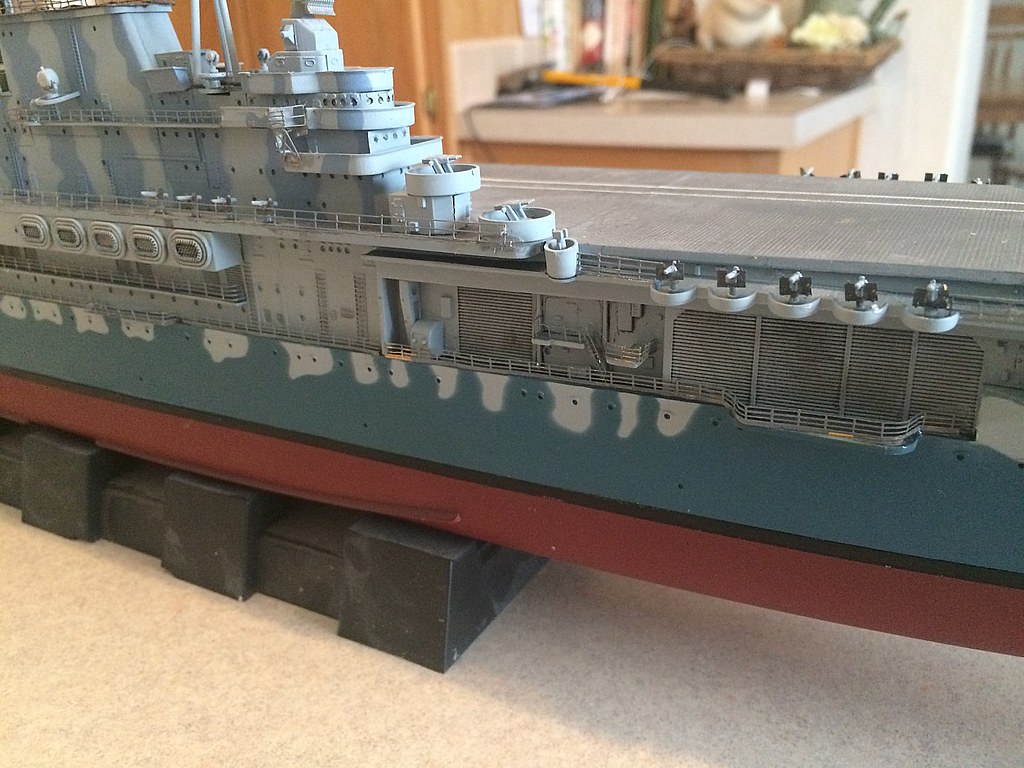
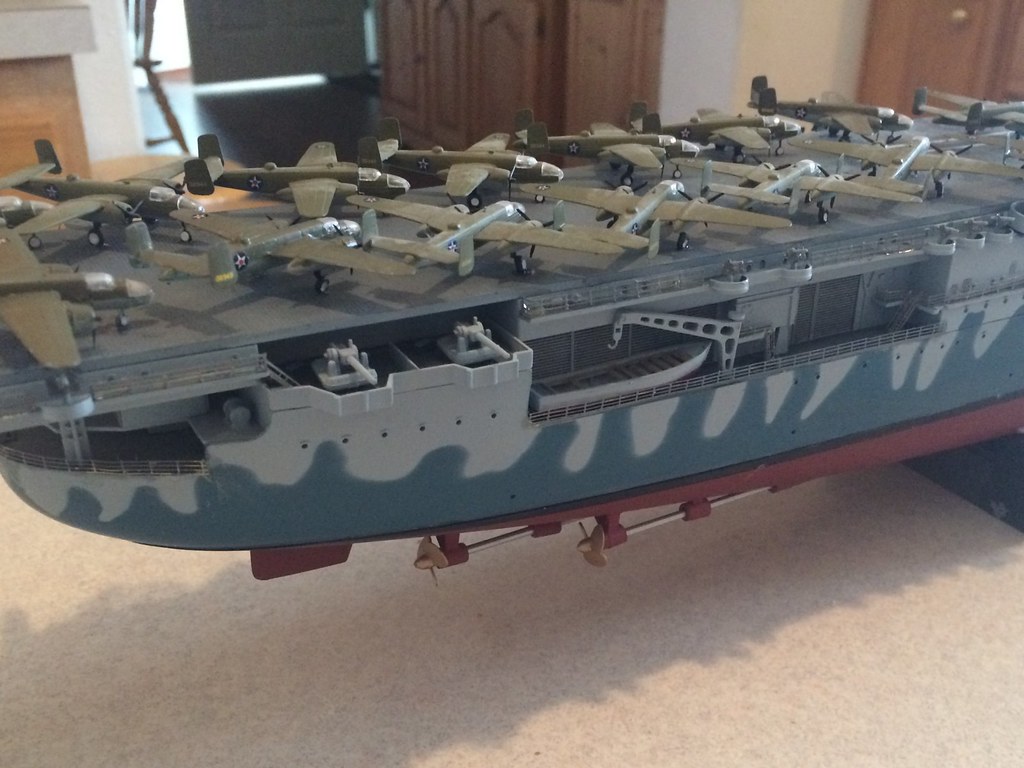
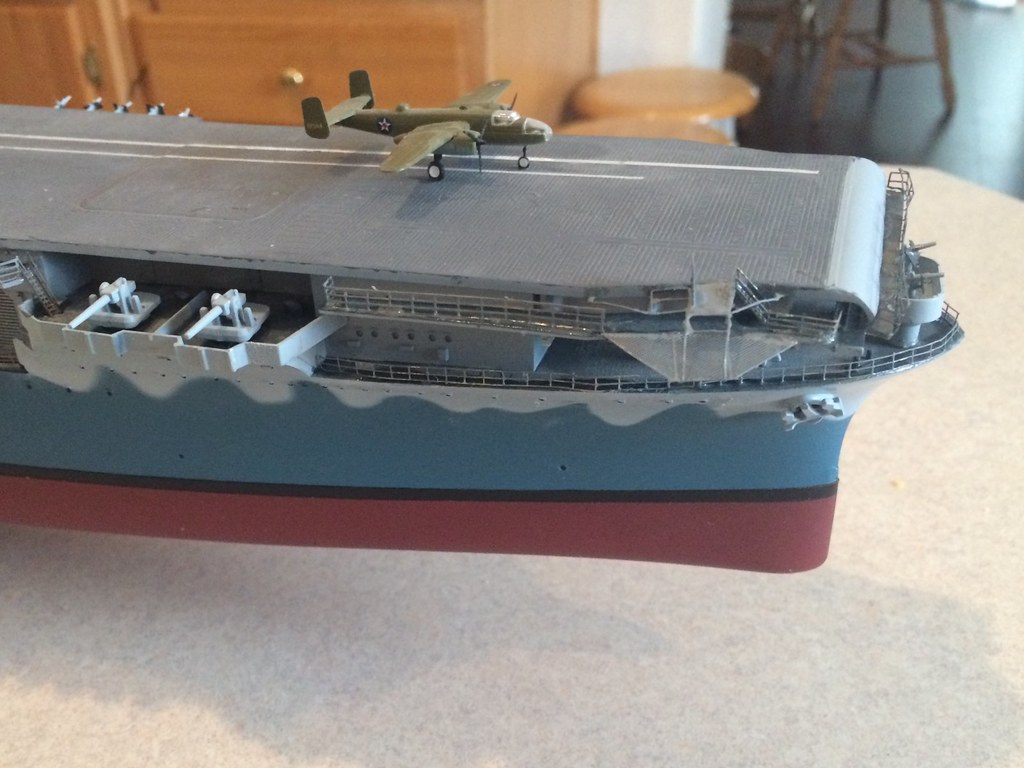
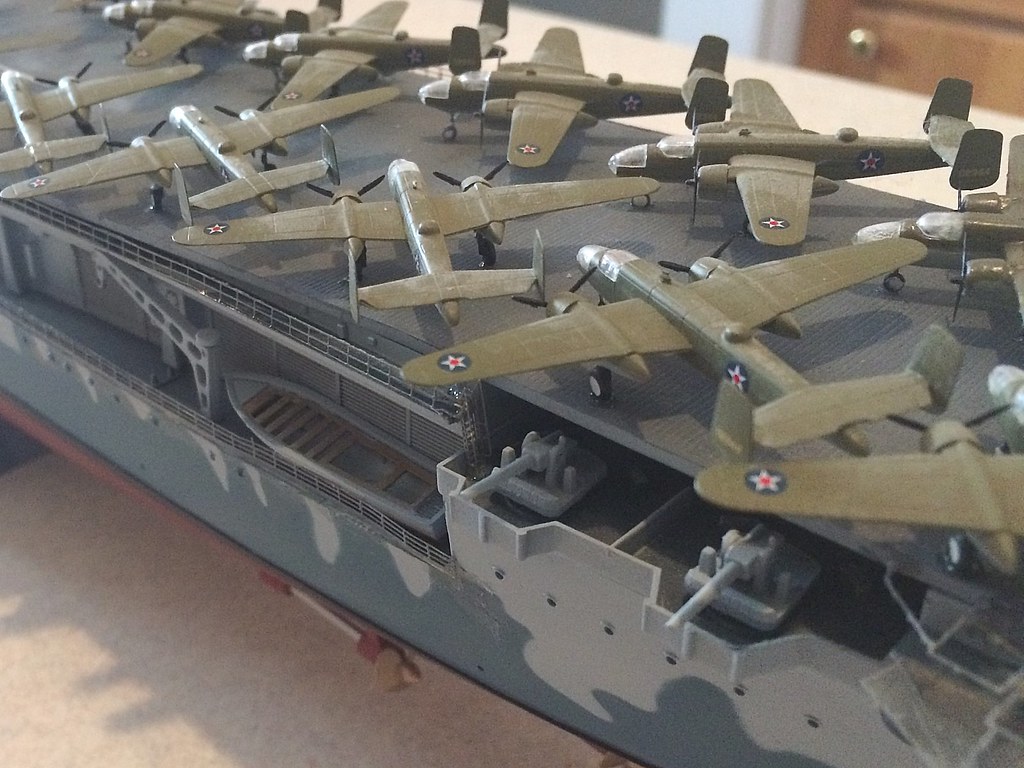
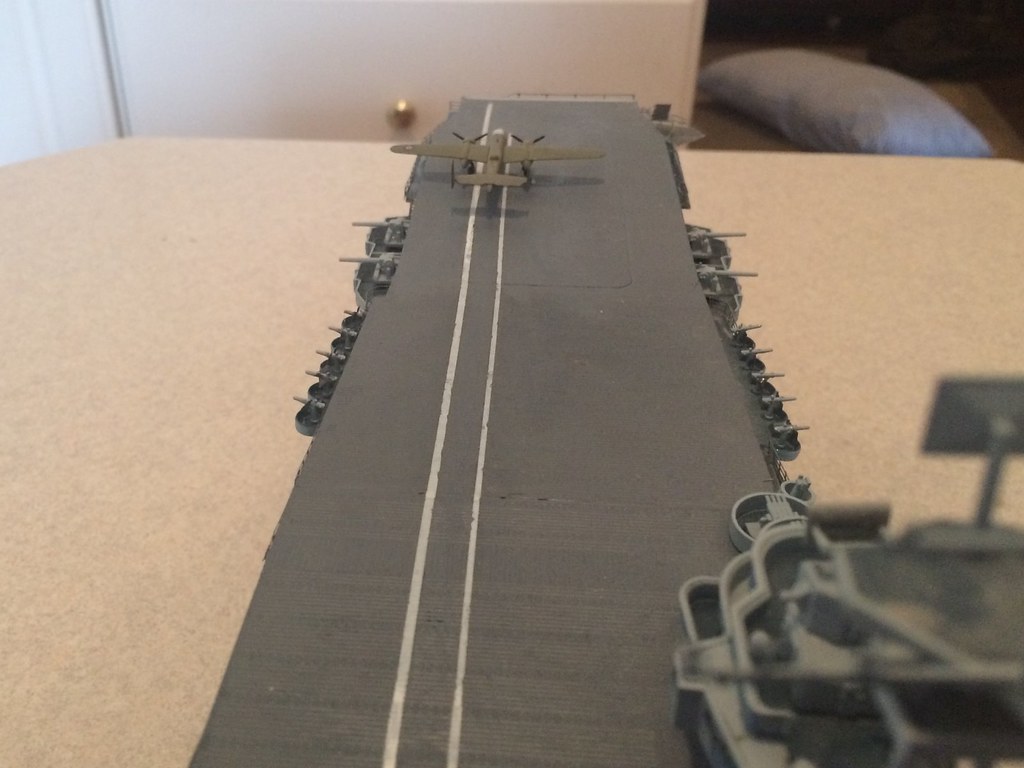
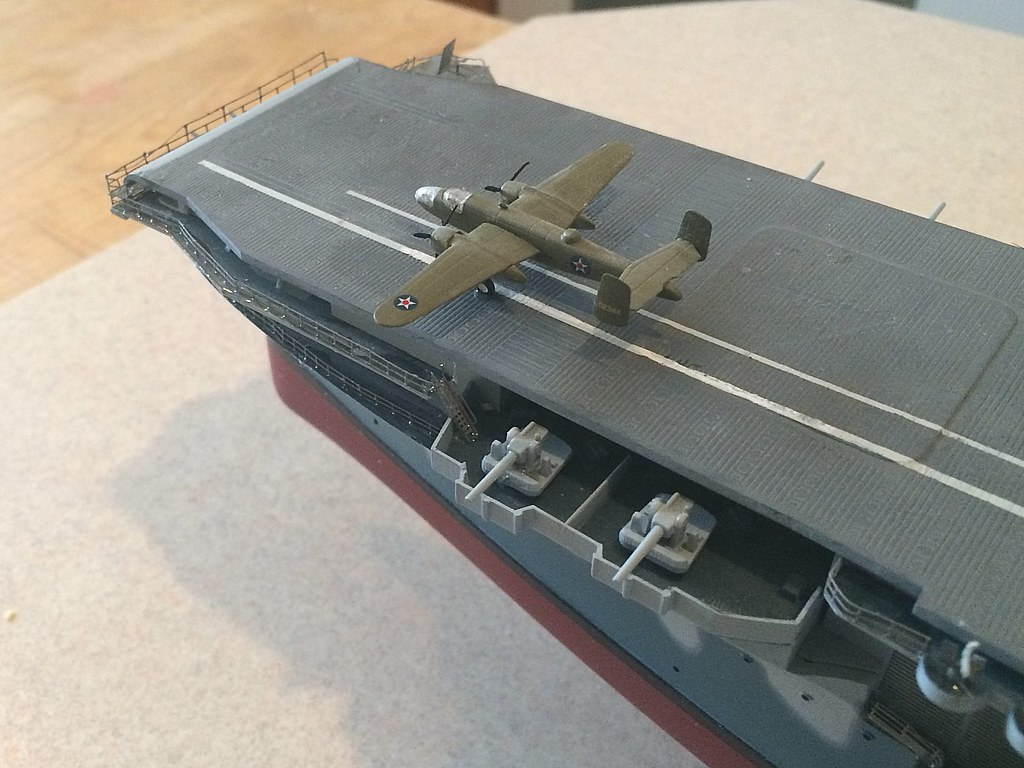
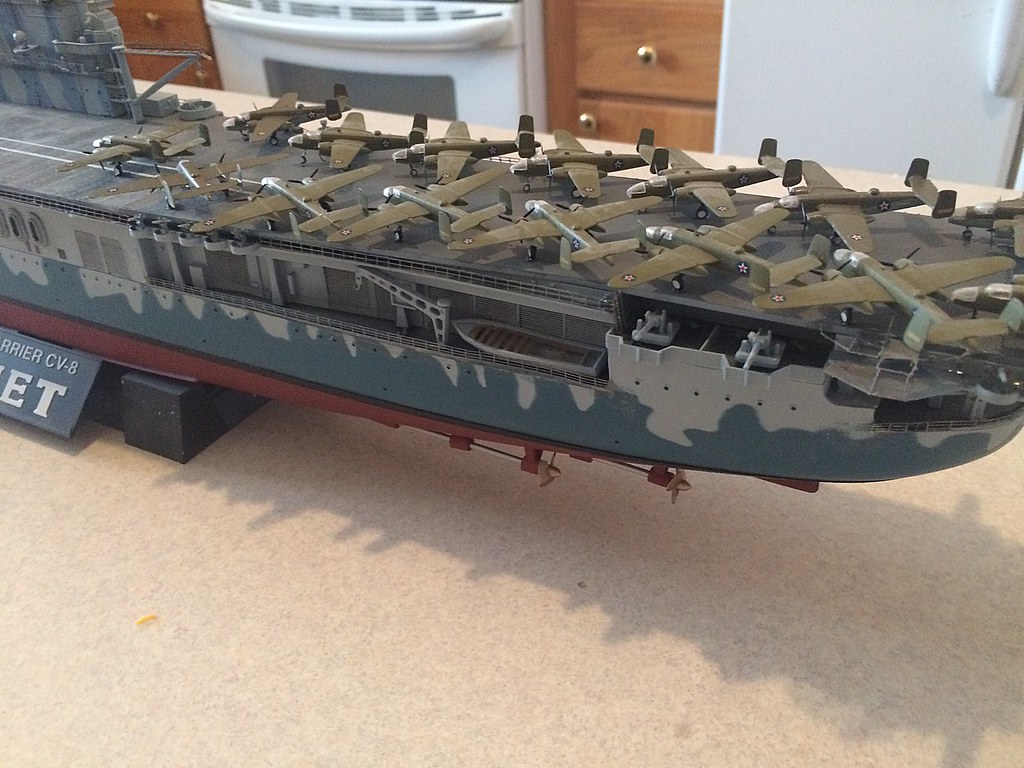
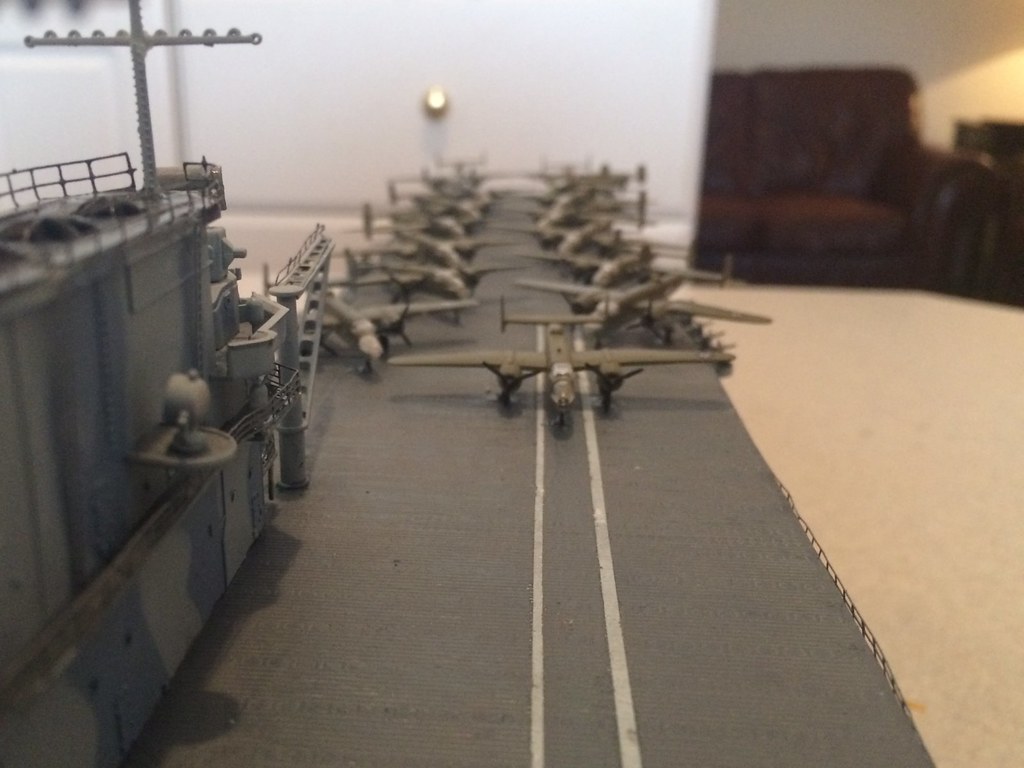
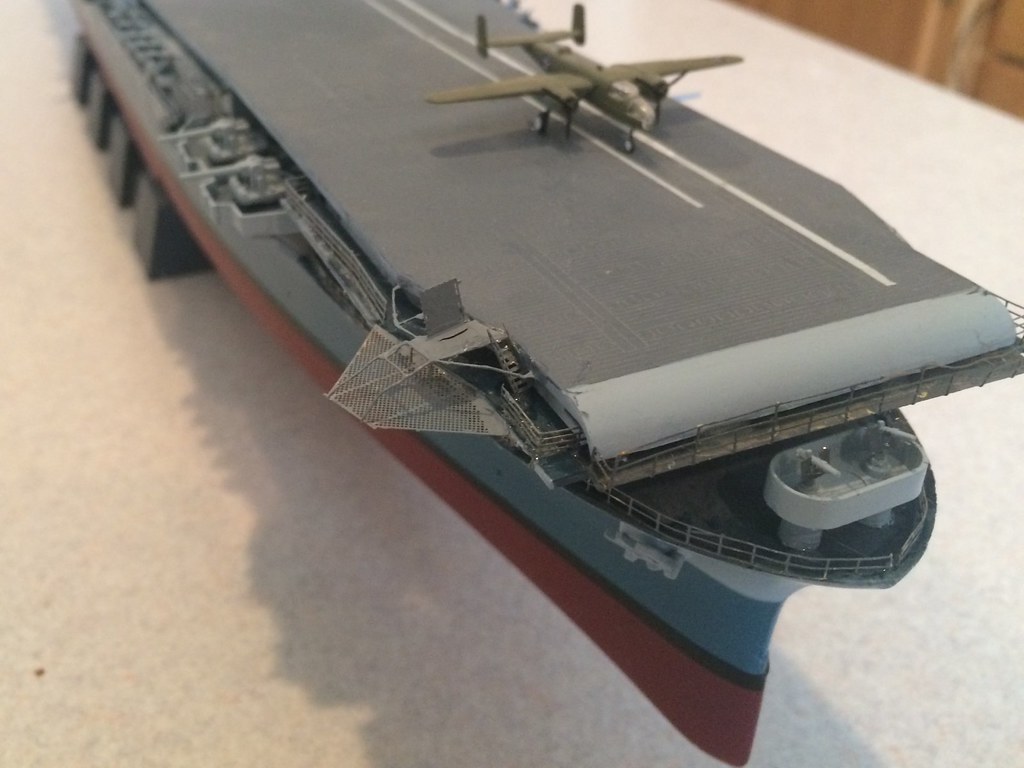
For using a pre-built model and then detailing her, this went pretty nice.
I have however decided that I enjoy more building the entire kit and adding the details as I go, including the hangar deck, which was not provided with this kit.
Just the same, she looks pretty good and will look even better with the destroyers, the cruiser, and the enterprise.
I will proceed next with the destroyer, then the cruiser, and then the Enterprise, which I intend to put some good effort into, having the full Merit International 1/350 cale kit and some add ons for it.
I have the Dragon Gleaves class destroyer, and ta Trumpeter New Orleans class crusier, which were two of the types in the taks force.
SCHEDULE for Future Activities
- February 21, 2017
- By March 10, 2017 complete Dragon Gleaves class destroyer 1/350 scale
- By March 20, 2017 complete New Oleans class cruiser in 1/350 scale
- By May 1, 2017 complete the WW II USS Enterprise, CV-6, in 1/350 scale
The completion of the PLAN Carrier group was centered on the already completed Trumpeter's 1/350 scale PLA Navy's Aircraft Carrier CV-16, Liaoning, (in addition to the other escorts already completed) included Mini Hobby's PLAN Guangzhou, DDG-168. I recently pre-ordered a 1/350 scale model of the PLAN Type 071 LPD, Yuzhao Class, announced by Dragon and due out in October, 2013. I will end up adding two of those, probably LPD-998 Yuzhao and LPD-999, Jinggangshan, add the PLAN- DDG-139, Ningbo, and the PLAN DDG-115, Shenyang, along with the PLAN Weifang, FFG-550 and thus build a PLAN ARG.
The completion of the US Carrier Strike group was centered on the completed Tamyia's 1/350 scale USS Enterprise, CVN-65, (in addition to the other escorts already completed) included Dragon's, USS Freedom, LCS-1, Dragon's USS Preble, DDG-88 and Hobby Boss's USS Texas, SSN-775. When a 1/350 scale USS Enterprise, CVN-80 (or any Gerald R. Ford Class) is released from Dragon, Tamiya, Dragon, or whomever else, I will add it to this group along with another AEGIS Cruiser. Whichever Ford Class coms out in 1/350 scale, I will build it as the USS Enterprise, CVN-80.
The US ARG includes Tamiya's 1/350 scale, USS Iowa, BB-62 (which I have already completed), Gallery's 1/350 scale USS Iwo Jima LHD-7, Gallery's 1/350 scale (already completed), USS New York, LPD-21 (Completed), Cyber Hobby's USS Independence, LCS-2 (Completed), Bronco Model's 1/350 scale USS Coronado, LCS-4 (Completed), a Flight IIA US AEGIS class destroyer based on Dragon's 1/350 scale USS The Sullivans, DDG-68 (Completed), a Ticonderoga AEGIS cruiser (Completed), and a 1/350 scale Orange Hobbies USS Harper's Ferry, LSD-49...all of these models which I already own.
The completion of the UK Group featured the Airfix 1/350 scale HMS Illustrious, R06 as its center piece until a 1/350 scale Queen Elizabeth carrier is released. When that happens, I will add that carrier to the group as its centerpiece. The Royal Navy CSG will also include two Airfix 1/350 scale Daring Class DDGs (one of which is already completed), two Dragon 1/350 scale Type 23 HMS Duke class Frigates (one of which is already completed), and the Hobby Boss 1/350 scale HMS Astute SSN (which is also already completed) and Airfix 1/350 scale HMS Trafalgar SSN. One day, when a 1/350 scale HMS Ocean LPD comes out, I will use it to start building a Royal Navy ARG.
The French CSG is centered on Heller's 1/400 scale Charles De Gaulle, R91. I have purchased the 1/400 scale Heller French De Grasse, D612 DDG, which is an ASW DDG, the French Aconit F713 and Gueprattet F714 Lafayette FFGs, both of which are Lafayette class frigates. These four vessels round out my French CSG and are all completed. As soon as a French Robin class nuclear sub, like the French Pearle S606 SSN is released in 1/350 or 1/400 scale, I will add that to the group. Also as soon as the Forbin D620, Horizon class anti-air DDG is released in 1/350 or 1/400 scale, I will purchase one of them for the AAW defense DDG. One day, when a Mistral Class LPD is released in 1/350 or 1/400 scale so I will create a French ARG.
The completion of the Japanese JMSDF group was centered on Fujimi's very finely detailed, 1/350 scale Hyuga, DDH-181. It will be escorted by Dragon's 1/350 scale DDG-177, Atago, an AEGIS class DDG and the JMSDF, DDG-174, Kongo class (which I own), Dragon’s 1/350 scale DDG-114 Susunami and DDG-111 (both of which are Takinami Class DDGs which I own), and by the 1/350 scale SS-503 Hakuryu (which I own), one of Japans new, very modern and capable AIP Diesel Electric submarines. It also included a Arts Technic 1/350 scale, DDG-116 Teruzuki (Akizuki class) destroyer. Should a 1/350 scale Osumi Class LPD and/or the larger 1/350 Izumo class DDH be released, I will buy those vessels and add them to the group.
Then, finally the Russian CSG (centered on Trumpeter's Kuznetsov which I own) the Russian Kirov Class nuclear battle cruiser (CGN), the Peter the Great, by Trumpeter, the Russian Slava Class cruiser, Varyag by Dragon (which I own), two Dragon 1/350 scale Udaloy DDGs (which I own), Hobby Boss's Akula II class SSN (which I own), and the new Yasen class Russian SSN (which I own), all in 1/350 scale. These are all completed as well. Sometime in the more distant future when a 1/350 scale Russian version of the French Mistral class comes out (which is building in real life right now), I will add two of those and build a Russian ARG.
Recently I purchased Heller's 1/400 scale Foch, the Clemenceau Class carrier that was sold to the Brazilians in 2000 and in 2002 was refitted and became the Brazilian CV, Sao Paulo, using steam catapults. I will build the model as the Sao Paulo and thus start a Brazilian group, though the Type 22 DDGs and the FFGs the Brazilians use are not available at present. I have however purchased a set of 1/400 scale A-4 Skyhawks and S-3 Trackers to build a suitable air wing for the Sao Paulo.
Then, again, once the models are available, I'd like to build an Italian Carrier Strike Group centered on the Cavour and their Horizon DDGs, a Spanish Carrier Strike Group centered on the Juan Carlos and their F-100 AEGIS FFGs, and ultimately an Australian Strike Group centered on the new Canberra Class LPD and the Hobart class AEGIS DDGs. If they ever build the models, an Indian Carrier Strike Group centered on either the Vikramaditya or their new ADS Carrier, the Vikrant, and their Kolkata class DDGs and Shivlak class FFGs would also be nice.
Years more worth of work!
You can see all of these actual carriers, read their histories and specifications at my site:
WORLD-WIDE AIRCRAFT CARRIERS